Soilsare different—very different—from one another. The average organic mineral soil is made up of 45 percent mineral particles; 5 percent living and dead organisms such as bacteria, protozoa, microbes, fungi, and earthworms; and 50 percent air and water. Three major factors contribute to cannabis roots’ ability to grow in a soil: texture, pH, and nutrient content (organic and mineral).
Most gardeners look at soil in two basic ways. The first is to see it as a living, organic substance that must be nurtured in order for cannabis roots to extract the necessary nutrients quickly, efficiently, and in maximum amounts. There are large volumes of soil in outdoor gardens and in large containers placed in greenhouses or indoors, and for such volumes, we can apply complete organic principles. The second way to look at soil is as a growing medium that holds chemical elements, salt-based fertilizers (nutrients), air, and water. Indoors and often in greenhouses this is the way many gardeners approach growing.
Dirt, Soil, and Soilless Mix
Dirt is found under your fingernails. Soil is mineral-based and best employed to grow cannabis in fields, planting beds, and very large containers. Soilless mixes are best for growing cannabis in small containers—indoors, outdoors and in greenhouses. The dynamics of small containers are not the same as in large containers, planting beds, or Mother Earth.
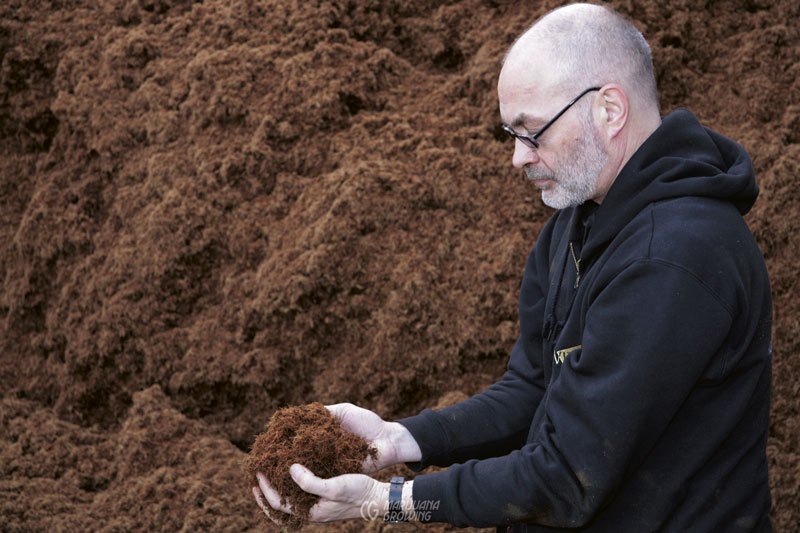
Many soils and soilless mixes used by cannabis gardeners are peat-based and are mixed with other elements.
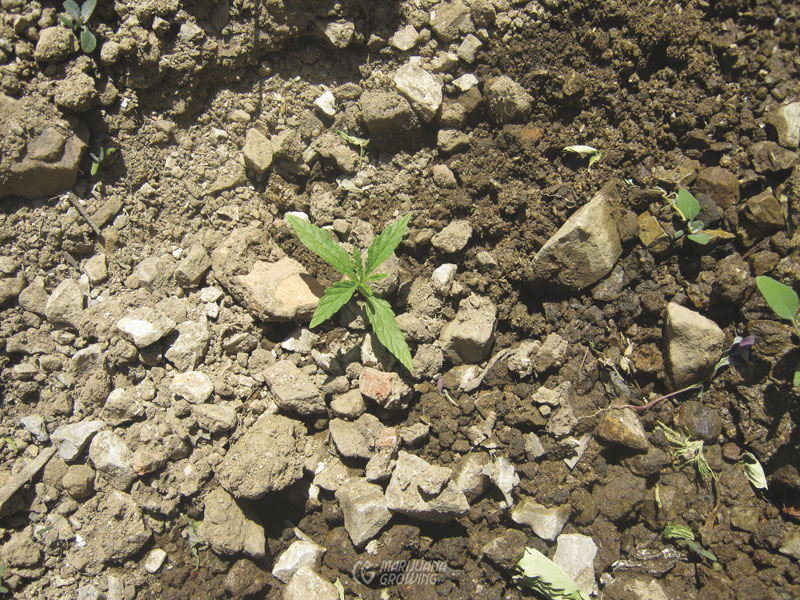
Rocky, clayey soil is packed with nutrients, but its texture restricts air and moisture content.

Heavy clay soil is easy to spot. It clumps up readily, is difficult to work, and drains poorly.
Soil texture is governed by the size and physical makeup of the mineral particles. Proper soil texture is required for adequate root penetration, water and oxygen retention, and drainage as well as many other complex chemical processes.
“Soil texture” is a descriptive tool used to express mineral particle sizes and grains in sediment, and is divided into three main groups, clay, loam, and sand. Most soils are a mix of three basic soil particle sizes: clay, silt, and sand (described below).
Soil pH is a measure of the acid-to-alkaline balance. Soil life and mineral (nutrient) availability and uptake by roots are affected by soil pH levels. Every full-point change in the 0 to14 pH scale denotes a tenfold increase or decrease. Nutrient uptake is best within a pH range of 6.0 to 6.5. Keeping the soil and water pH-balanced and within the proper range is essential to a strong, healthy cannabis crop.
Soil varies from location to location on the earth and often varies from one place to another in your own backyard.
Soil Tests
Soil tests are remarkably inexpensive ($20–$200 USD) and save medical cannabis gardeners much time and money wasted on fertilizers. Such tests also save the environment from excessive fertilizer pollution, including nitrates and phosphates, accumulation in the soil, and runoff in the watershed. Excess fertilizer salts wash out into the water system where they cause countless environmental and health problems. For example, home gardeners use at least ten times more fertilizer per square yard (m2) than big agribusiness farms. For every $10 USD spent on fertilizer by home gardeners, $9 USD is wasted! I recently spoke to an outdoor medical cannabis gardener who spends $3,000 USD on fertilizer annually. By applying the above information we see that 10 percent ($300 USD) worth of fertilizer is actually used and 90 percent ($2,700 USD worth of fertilizer) is washed into the soil and groundwater. The gardener could easily save $2,700 USD by investing $20 to $200 USD in soil tests and the following recommendations.
Familiarize yourself with 2 basic types of soil analysis: base cation saturation ratio (BCSR) and sufficiency level of available nutrients (SLAN).
Base cation saturation ratio is commonly used by organic farmers and market gardeners in many countries. The results of BCSR testing provide the actual amounts of nutrients in soil. The goal of BCSR testing is to achieve a balanced ratio of nutrients. The methodology uses Mehlich 3 extraction with different testing parameters. The BCSR soil-testing method is supported by the National Sustainable Agriculture Information Service (ATTRA).
Standard soil tests provide information for some or all of the following:
• calcium
• magnesium
• potassium
• sodium
• phosphorus
• sulfur
• chlorine
• minor elements
• trace elements
Get a BCSR soil analysis ($110–$150 USD) from Earthfort, http://earthfort.com/lab services.html.
Also known as Index (UK) system, SLAN is used by the majority of universities, farmers, and big agribusinesses worldwide. The results of this type of test provide plant-available nutrient levels in a well-known range, ensuring neither a deficiency nor an excess. The methodology uses ammonium acetate extraction.
Standard SLAN soil tests provide some or all of all of the following and many include recommendations to improve soil nutrient content.
• pH
• ECe (dS/m)
• NO3-N (ppm)
• NH4-N (ppm)
• PO4-P (ppm)
• potassium (ppm)
• magnesium (ppm)
• calcium (ppm)
• sodium (ppm)
• SO4-S (ppm)
• zinc (ppm)
• manganese (ppm)
• iron (ppm)
• copper (ppm)
• boron (ppm)
An optimum range for each reading and amendment and fertilizer recommendations are also included in many soil tests. For a little more money many labs include an easy-to-read graph.
SLAN Soil Test Labs
Logan Labs, LLC: Least expensive soil tests I have found. Basic test $20 USD. www.loganlabs.com
A&L Western Laboratories, Inc.: Excellent service at a reasonable price. https://al-labs-west.com/
Spectrum Analytic, Inc.: This lab does everything and also shows a sample soil test. www.spectrumanalytic.com
Regardless of the type of test you choose, BCSR or SLAN, follow soil collection and submission guidelines to the letter. Gardeners living in a state or country that sanctions medicinal cannabis can send tests to local labs and request recommendations for cannabis. Medical gardeners who do not live in such a state can send their soil samples to any soil test lab but are advised not to mention the target crop.


Excellent sites to learn more about soil:
• Soil and Health Library provides free e-books, mainly about holistic agriculture, holistic health, and self-sufficient homestead living. https://soilandhealth.org
• Soilminerals.com provides complete information on garden soil minerals, nutrients, trace minerals, fertilizers and amendments for all gardens, farms, lawns, orchards and greenhouses. www.soilminerals.com
• University of Idaho, College of Agriculture offers a short course in soil and plant diagnostics. www.webpages.uidaho.edu/~bmahler/s44603.pdf
• Acres USA is North America’s oldest magazine covering commercial-scale organic and sustainable farming. www.acresusa.com
• National Sustainable Agriculture Information Service (ATTRA) manages projects that promote self-reliance and sustainable lifestyles that include sustainable and renewable energy, energy conservation, resource-efficient housing, sustainable community development, and sustainable agriculture. www.attra.ncat.org
• Jorge Cervantes Presents Marijuana Growing. Check our site, which includes a forum for updates and current discussion! www.marijuanagrowing.com
• Google William A. Albrecht, PhD, a famous agronomist who pointed out the direct relationship between soil fertility and human health. www.google.com
Plant Tissue Analysis
Analyzing plant tissue for nutrient accumulation and utilization is common among professional farmers and greenhouse growers. The tests cost less than $40 USD and help growers fine-tune fertilizer application. A small investment in periodic plant tissue analysis will lower fertilizer bills and increase yields, often substantially. Legal medicinal cannabis gardeners are also able to request plant tissue analysis from agricultural laboratories within states and countries that sanction medical cannabis.
Soil tests measure nutrient levels that are potentially available for uptake by roots.
The test is normally performed before planting, and it does not measure the actual concentration of nutrients inside of plants. For example, nitrogen is often deficient in plants even though it may be readily available in the soil. A tissue analysis, on the other hand, will provide current data to make timely decisions.
Plant tissue analysis also helps ensure plants are not overfertilized. High concentrations of nitrogen, in particular, may affect human health because excess nitrates can convert to nitrites while being digested in the gut. Nitrates may react with other compounds to form nitrosamines that may be carcinogenic.
Fine-tuning fertilization programs, including micronutrient levels, is much easier when accurate information from analysis of plant tissue is available. Micronutrients are required in minute amounts, and an overdose could easily stunt a crop or significantly diminish yields.
Soil gardeners are able to test soil, which gives them an idea of which nutrients may be lacking. They can use subsequent plant tissue analysis to concentrate on determining amounts of specific elements and how those elements are utilized by plants.
Hydroponic gardeners, who do not have soil tests at their disposal, find plant tissue analysis especially useful.
Plant tissue analysis often takes 1 to 2 weeks when a specimen is sent to a laboratory. When crops are grown for 10 to 12 weeks total, this might be 10 percent of the plant’s life. But, nitrogen tests* can be completed on the spot with a handheld meter in the garden, and results are available immediately.
*A chlorophyll concentration meter measures chlorophyll content index (CCI) in foliage and the nitrogen content is extrapolated from this data. One molecule of chlorophyll contains four nitrogen atoms.
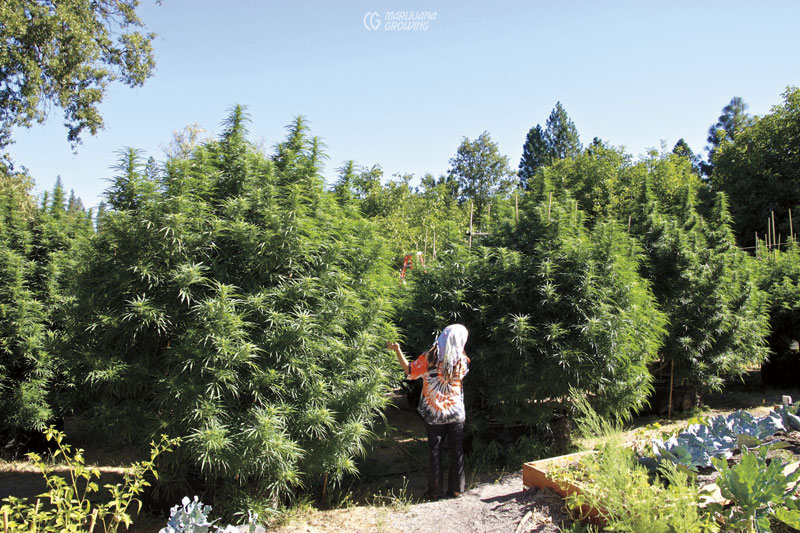
A soil test and the proper organic amendments before planting saved this gardener hundreds of dollars in fertilizer.
Texture and Types of Soil
To feel its texture, pick up a handful of moist outdoor soil and rub it between your fingers. Heavy clay soil will feel slick and greasy. Sandy soil feels grainy and rough. Silty soil will feel soft and spongy and be dark in color.
Pick up a handful of moist potting soil and gently squeeze it to feel the texture. The soil should barely stay together and have a sponge effect when you slowly open your hand to release the pressure. Potting soils that do not fulfill these requirements should be thrown out or amended.
The cation exchange capacity (CEC) of a growing medium is its capacity to hold cations that are available for uptake by the roots. The CEC is the number of cation charges held in 3.5 ounces (100 gm or 100 cc) of soil and is measured in milliequivalents (mEq) or centimoles/kg on a scale from 0 to 100. A CEC of zero means the substrate holds no available cations for roots. A CEC of 100 means the medium always holds cations available for uptake by roots. Growing mediums that carry a negative electrical charge are the best.
Cation exchange capacity is a calculated value that estimates the ability of a soil to attract, hold, and exchange cation elements; CEC values are reported in milliequivalents per 100 grams of soil (mEq/100 gm). Soil-sample testing laboratories report a value for the CEC. Use the CEC numeric value on your report and then compare the number to the graph below to find your soil type.
High-CEC soils hold more nutrients and water. But soils with high levels of clay (and high CEC readings) allow little room for oxygen and can slow root growth and nutrient uptake. If acidic, high-CEC soils also require more lime to buffer and lower pH.
Nutrients take more time to leach out of high-CEC soils.
Low-CEC soils hold nutrients poorly, which requires more frequent irrigation and lower volumes. These soils have a low capacity to retain cations. Add humus-based amendments to acidify and balance low-CEC soils.
Nutrients must be dissolved in (water) solution in order to be absorbed by roots. When dissolved, they are in a form called “ions.” This means that they have electrical charges. An electrical charge is either positive (+) or negative (-). For example, table salt, sodium chloride (NaCl), becomes 2 ions when dissolved: sodium (Na+) and chloride (Cl-). The sodium ion with a positive (+) charge is called a “cation,” and the chloride ion with a negative (-) charge is called an “anion.” In chemistry, opposites attract and likes repel one another. In ionic form, nutrients are attracted to opposite charges—positive attracts negative and vice versa.
Soil chemistry can become very complex, and it is beyond the scope of this book to dig deeply into the subject. For more information on the subject, check www.marijuanagrowing.com.
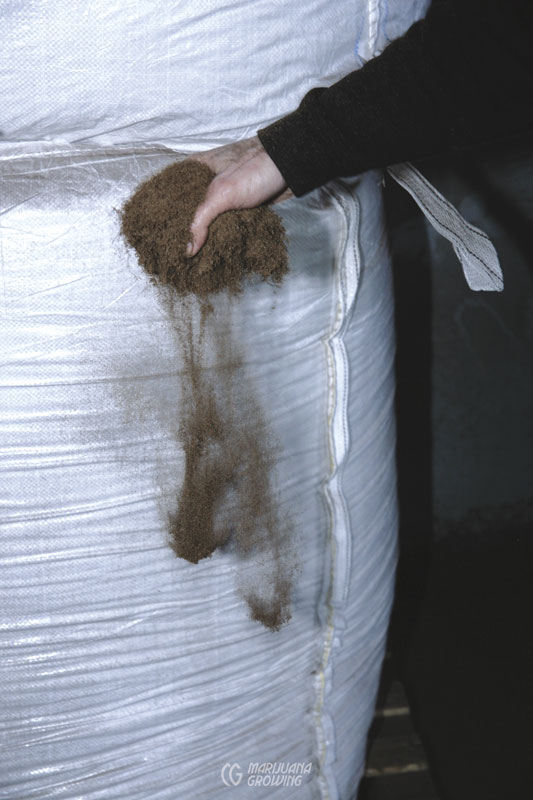
This soilless mix is super dry but light and powdery. It holds a lot of water and air at the same time.
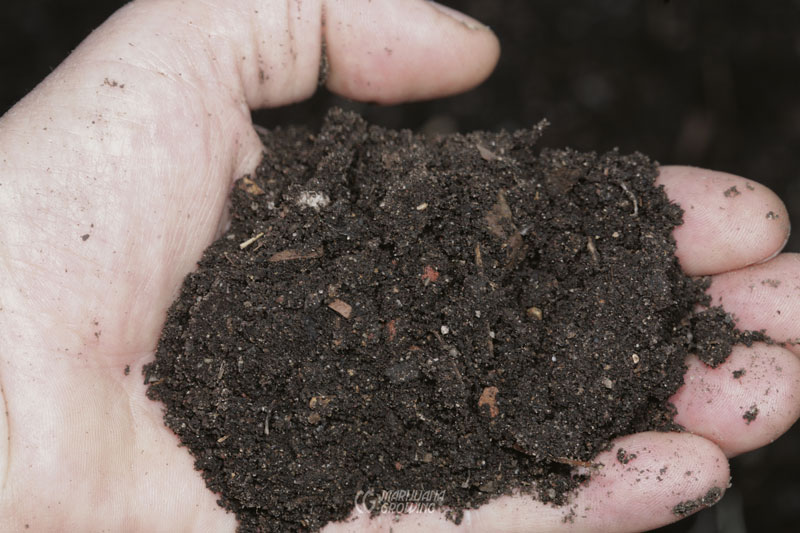
This handful of soil has everything necessary for strong plant growth.
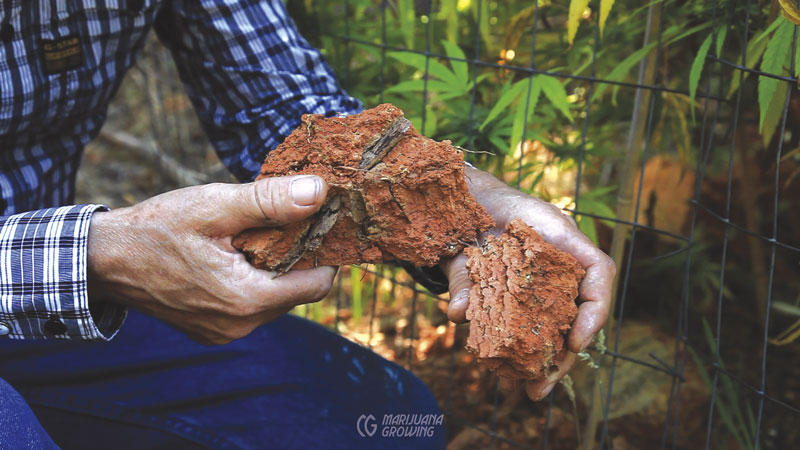
This is very heavy clay soil. It is great for making pottery but horrible as garden soil.
Use this table to estimate the CEC of your soil:
| SOIL | MIN. | MAX. |
|---|---|---|
| CEC | CEC | |
| sand | 1 | 4 |
| sandy loam | 5 | 8 |
| silt loam | 8 | 20 |
| clay loam | 20 | 40 |
| clay | 40 | 80 |
CEC of popular growing mediums measured in mEq/100 grams
- compost 90
- Sunshine Mix 90
- peat moss 80
- garden soil 70
- expanded clay 20
- vermiculite 20
- perlite 00
- rockwool 00
This list shows different growing mediums’ ability to hold positive charges that are ready for root uptake. Note the zero CEC of perlite and rockwool. Roots must be constantly bathed in nutrients. Other mediums do not provide a constant flow of nutrients and the CEC regulates the ability to hold a positive charge to make nutrients available for root uptake.

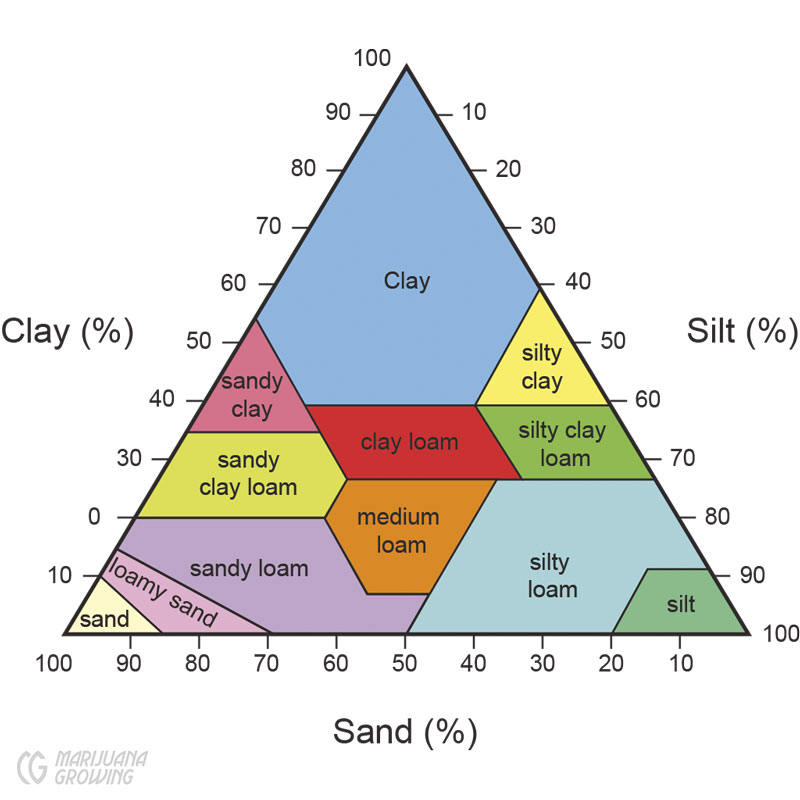
This cutaway drawing shows how roots penetrate the soil. Note: There must be enough air trapped in the soil to allow biological activity and absorption of nutrients.
Clay soil consists of very small, flat mineral particles that have a strong negative ionic charge. In fact, the negative electrical charge often ties up calcium, magnesium, potassium, and sodium in clay soil. Minute mineral particles pack tightly together, especially when wet, causing very slow drainage. Roots penetrate clay soil slowly, and damage from waterlogging is more common. Clay soil has little or no space for oxygen, the lack of which slows nutrient uptake. Clay soil can be very difficult to till; it is often extremely heavy when wet and is known to clump up.
Amend clay soil with compost, manure, gypsum, etc. (See Organic Soil Amendments later in this chapter for a complete list.) Incorporating compost, manure, or other organic amendments in the fall is one of the best ways to improve clayey and poor-quality soils. Raised beds are also an excellent option to combat clay soil. Till clay soil when it is damp and workable, and add manure, compost, or both.

The hard, clayey, rocky soil above is packed with nutrients but restricts root growth and water drainage. Plants shown here are in sunken beds to conserve moisture.
Sandy soil boasts the largest particles that permit good aeration and drainage. Drainage can be too fast if particles are too big. The texture of sandy soil is somewhat gritty depending upon the size of its mineral particles. Sandy soil is easy to cultivate and warms quickly in the spring, but low water-retention rates mean that frequent watering is necessary. Amend sandy soil with compost and organic matter to help it retain water more evenly.
Silty soil is very fertile. It is composed of fine organic particles and minerals such as quartz. Silty soil is granular, like sandy soil, but it has more nutrients and offers better drainage. When silty soil is dry it has a smoother texture and looks like dark sand. This type of soil can hold more moisture and can at times become compacted. It offers better drainage and is much easier to work with when moist.
Soils are seldom all clay, all sand, or all silt. They are a combination of different types. This table demonstrates the different percentages of soil combinations.

Beautiful peat-rich soil is ideal for planting. This greenhouse and the field in the foreground produce nice, big gardens of medicinal cannabis.
| NAME OR TYPE OF SOIL | PARTICLE DIAMETER LIMITS |
|---|---|
| USDA Classifi cation | |
| clay | Less than 0.002 mm |
| silt | 0.002–0.05 mm |
| very fi ne sand | 0.05–0.1 mm |
| fine sand | 0.1–0.25 mm |
| medium sand | 0.25–0.5 mm |
| coarse sand | 0.5–1 mm |
| very coarse sand | 1–2 mm |
Other Soils
Loam soil is made up of sand, silt, and clay. Loam is considered by many to be the perfect soil. Its texture is often gritty, yet it retains plenty of air and water and drains well because of its different-sized particles. Depending upon its makeup, loam can range from heavy (clay) to light (sandy).
Peat (bog) soil is formed by the accumulation of dead and decayed organic matter. Found in rainy, marshy areas, the decomposition of organic matter in peat soil is blocked by soil acidity. Few nutrients are present even though peat soil is rich in organic matter. Peat soils are prone to waterlogging, so for best results, they must be mixed with other soils and compost before cannabis is planted.
Chalky soil is very alkaline in nature and is often packed with rocks. It is prone to dryness, and in summer chalky soil consumes much water and fertilizer. This soil also locks up iron and magnesium due to its high pH activity.
Alkali soils are packed with sodium carbonate, which is detrimental to cannabis growth. The farmland around my hometown is plagued with alkali soil. Many other regions in the world also suffer from alkali soil; the pH hovers around 8.5 and higher. Alkali salt is so abundant in many places that it appears as white powder that cakes up on the surface of soil. Alkali soils also significantly slow water absorption.
To “purge” alkali salt from soil, farmers cultivate with a tractor or tracked vehicle equipped with 30- to 36-inch (76–91 cm) “ripping bars.” Tilled fields are flood-irrigated with a foot (30.5 cm) or more of water to drive the alkali salts deep into the soil, beyond the depth of most roots. The salts rise to the surface over time, and the process is repeated every few years as needed.
Outdoor cannabis gardeners plagued with alkali soil should grow in large containers and amend the alkali soils with acidic elements, including peat moss. Use as little alkali soil in the container as possible, and before planting, leach the alkali soil heavily with water to wash out unwanted salts.
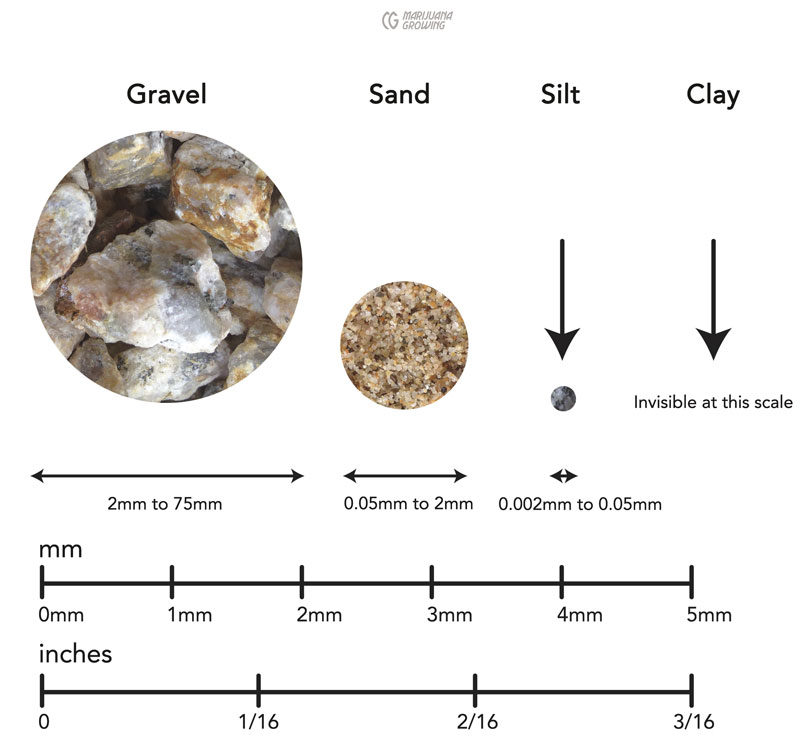
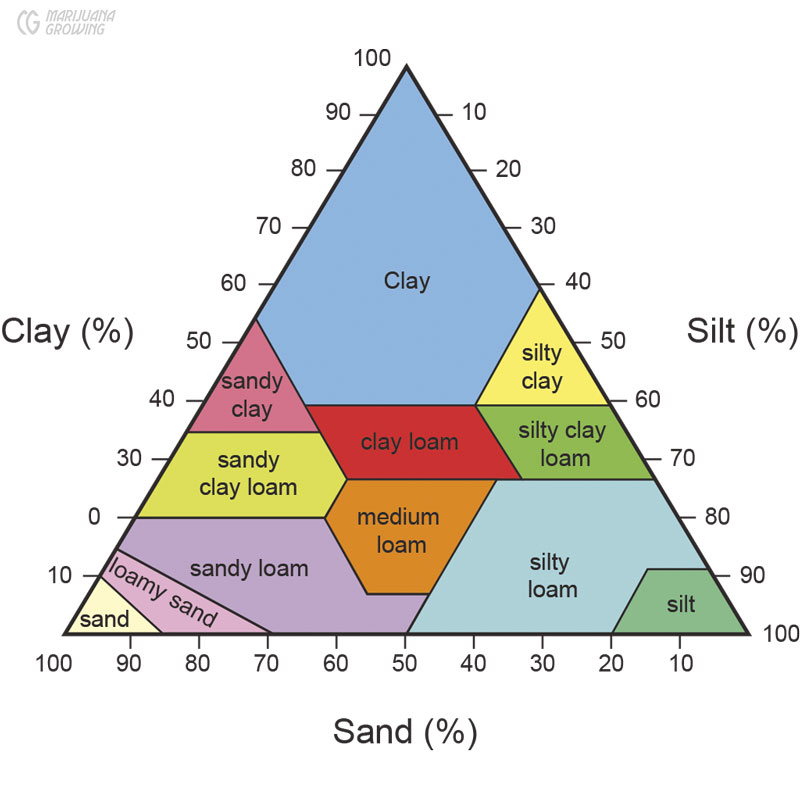
This soil pyramid demonstrates the diversity of most soils.
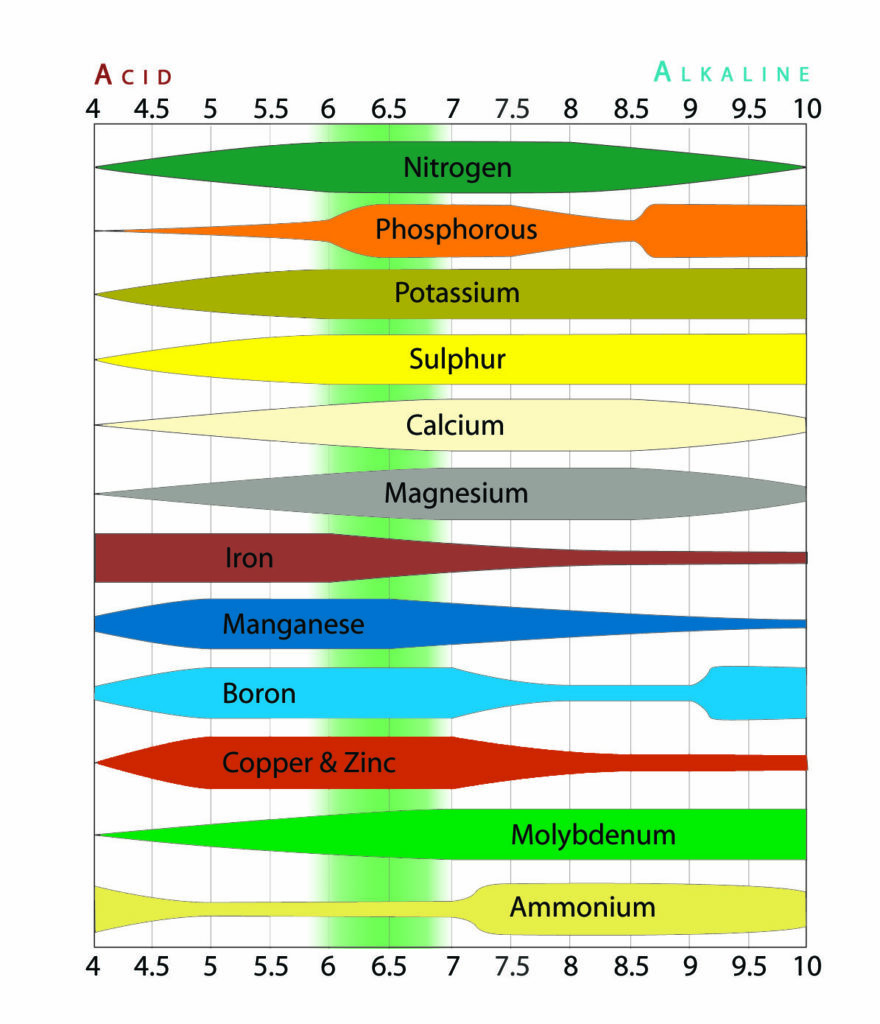
A simple pH chart shows the range in which most nutrients are available in soil.
Soil pH
Potential hydrogen (pH) is a scale from 0 to 14 that measures the concentration of either hydrogen (H) ions or hydroxide (OH) ions. Zero is the most acidic, 7 is neutral (also known as base), and 14 is the most alkaline. Every full-point change in the logarithmic pH scale signifies a tenfold increase or decrease in acidity or alkalinity. For example, soil or water with a pH of 5.0 is 10 times more acidic than soil or water with a pH of 6.0. Water with a pH of 5.0 is 100 times more acidic than water with a pH of 7.0. With a tenfold difference between each full point on the pH scale, accurate measurement and control are essential to ensure nutrient availability.
Cannabis grows best in soil with a pH from 6.5 to 7.0. Within this range cannabis can properly absorb and process all necessary available nutrients most efficiently. If the pH is too low (acidic), acid salts chemically bind nutrients (or, more correctly stated, the ion form changes in valence, or charge). The plant then only takes up a certain charged ion such as phosphate, the plant-available form (H2PO4 -) converts to the unavailable form HPO4 2- on pH rise and achieves equilibrium at pH 7.2, and the roots are unable to absorb the nutrients. An alkaline soil with a high pH causes nutrients to become unavailable. Excess unused nutrients in soil also cause toxic salt buildup that limits water intake by roots. It can also make some elements available at toxic levels when pH drops below 5.4!
The pH of soil mixes is very important because it dictates the ability of specific pH-sensitive bacteria. But I have experimented and irrigated well-managed organic soil with 8.0 pH water and higher. Once the rich organic soil absorbs the water, the soil life buffers the pH and it reverts back to 6.5 after a few minutes!
Hydroponic nutrient solutions perform best in a lower pH range than for soil. The ideal pH range for hydroponics is from 5.8 to 6.8. Some gardeners run the pH at lower levels and report no problems with nutrient uptake.
Measuring Soil pH
Measure pH with a litmus paper, a liquid pH reagent test kit, or electronic pH meter, all of which are available at most nurseries. When testing pH, take 2 or 3 samples and follow—to the letter—instructions supplied by the manufacturer. Soil test kits measure soil pH and primary nutrient content by mixing soil with a chemical reagent solution and comparing the color of the solution to a chart. Novice gardeners often have a difficult time achieving accurate measurements. Comparing the color of the soil/chemical mix to the color of the chart is often confusing. If you use one of these kits, make sure to buy one with good, easy-to-understand instructions, and ask the sales clerk for exact recommendations on using it.
If using litmus paper, collect samples that demonstrate an average of the soil. Place the samples in clean jars, and then moisten the soil samples with distilled water that has a pH of 7.0. Place 2 pieces of the litmus paper in the muddy water. After 10 seconds, remove 1 strip of litmus paper. Wait a minute before removing the other one. Both pieces of litmus paper should register the same color. The litmus paper container should have a pH-color chart on the side. Match the color of the litmus paper with the colors on the chart to get a pH reading. Litmus paper will accurately measure the acidity of the substance to within a point or less. The pH readings will not be accurate if altered by water with a high or low pH, and the litmus paper could give a false reading if the fertilizer contains a color-tracing agent.
Adjusting Soil pH
For an accurate pH test with an electronic pH meter:
- Clean the probes of the meter before and after each test, and wipe away any corrosion.
- Water the soil with distilled or neutral pH water before testing.
- Pack the soil around the probes.
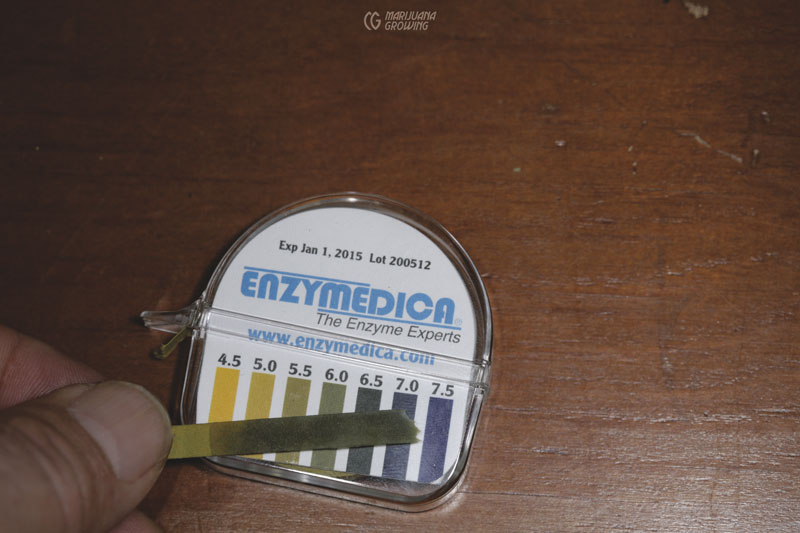
Litmus paper is relatively expensive and is fairly accurate.
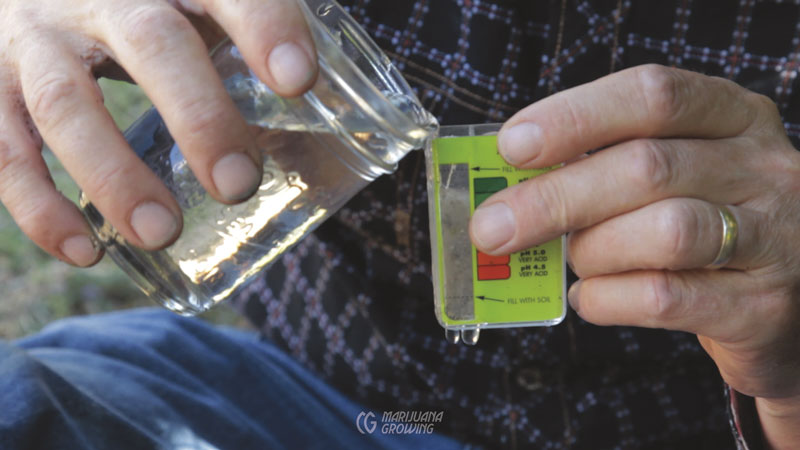
Mix water with a chemical in liquid pH reagent test kits.

This simple N-P-K and pH reagent soil test kit is inexpensive and easy to use.
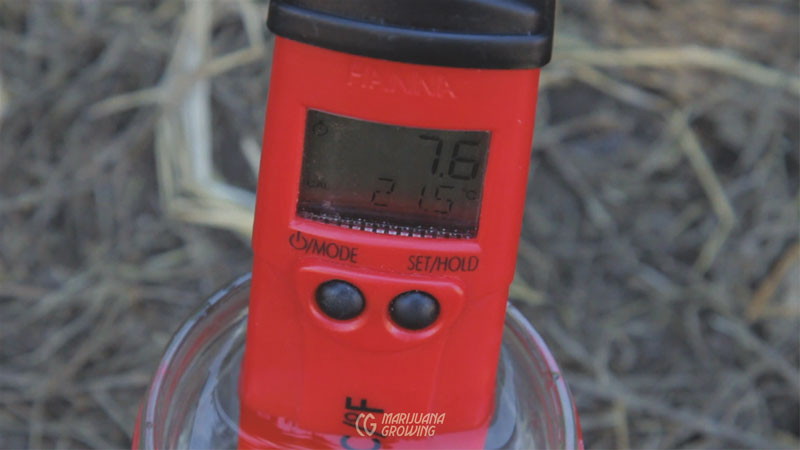
Electronic pH meters are economical and convenient. Also, remember to check the pH of irrigation water. See chapter 15, Meters, for complete information on electronic pH meters.
Lime amendments will raise pH and lower acidity, but too much lime can burn roots and make nutrients unavailable. If you need more than 1 full point of pH adjustment, check with local farmers, nurseries, or agricultural agencies for recommendations on lime application.
Lime application differs based on soil type. Some guidelines are:
- 35 pounds/300 square yards (16 kg/251 m²) for very sandy soil.
- 50 pounds/300 square yards (23 kg/251 m²) for sandy soil.
- 70 pounds/300 square yards (32 kg/251 m²) for loam.
- 80 pounds/300 square yards (36 kg/251 m²) for heavy clay soil.
As a rule of thumb, add 1 to 2 pounds (0.5–0.9 kg) of dolomite lime to each cubic foot (0.03 cm³) of soil.
Lowering alkaline levels is somewhat easier than raising the acid level. If your soil is too alkaline, you can reduce soil pH by 1 point by applying:
1.2 ounces (34 gm) of finely ground rock sulfur per square yard (90 cm²) for sandy soil.3.6 ounces (100gm) per square yard (90 cm²) for other types of soil.
*1 cubic yard is equivalent to 27 cubic feet (1 m³ is approximately equal to 106 cm³, and 1 cubic yard is approximately equal to 105 cm³).
Well-decomposed sawdust, composted leaves, and peat moss are effective amendments for acidifying soil and reducing pH levels.
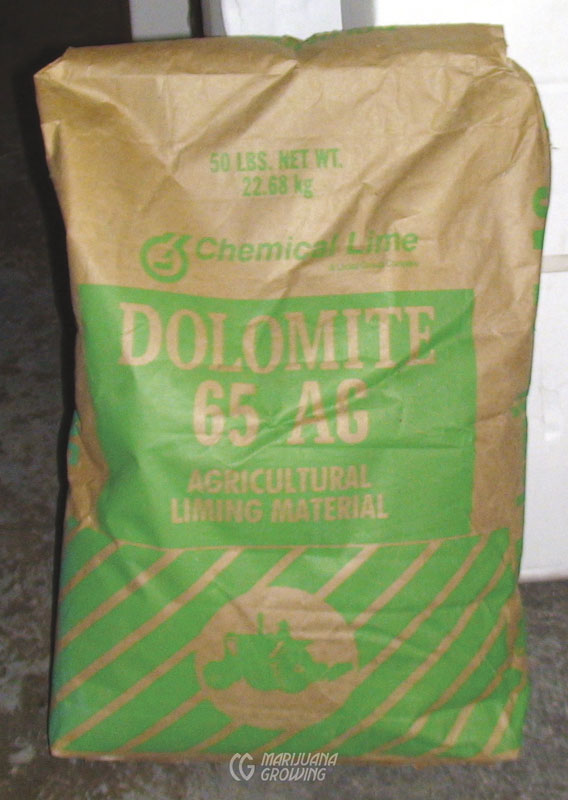
When planting, add 1 cup of fine dolomite lime to each cubic foot (1 ounce per gallon [30 ml per 4 L]) of planting medium to stabilize the pH and provide calcium and magnesium.
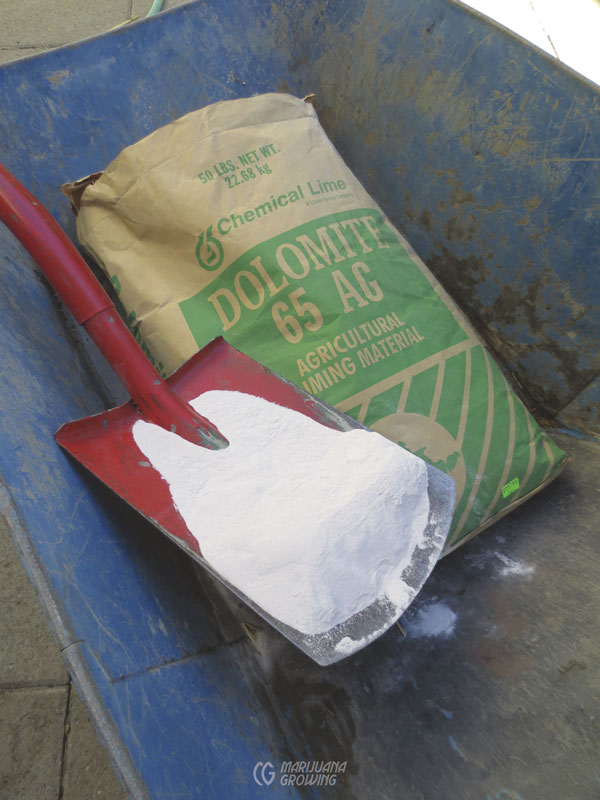
Dolomite lime is an essential additive for most garden soils and soilless mixes.
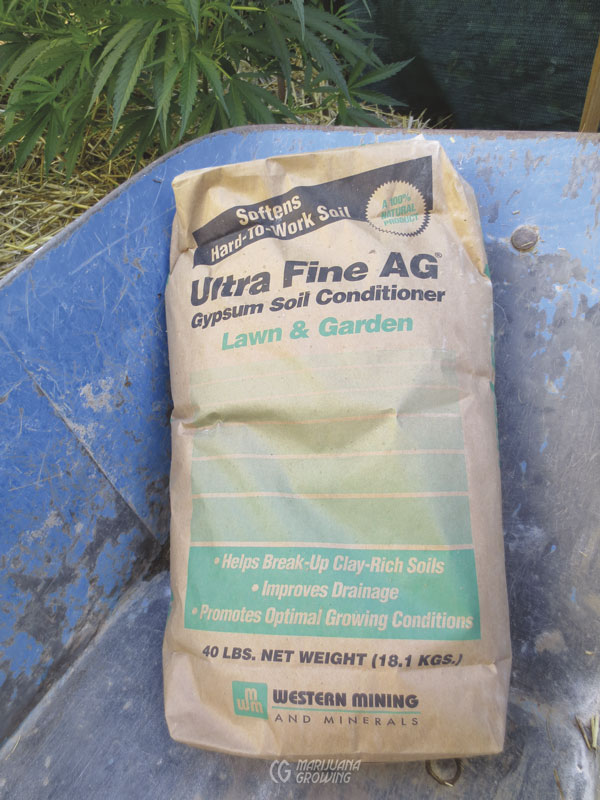
Gypsum is rich in calcium and works wonders in cannabis gardens.
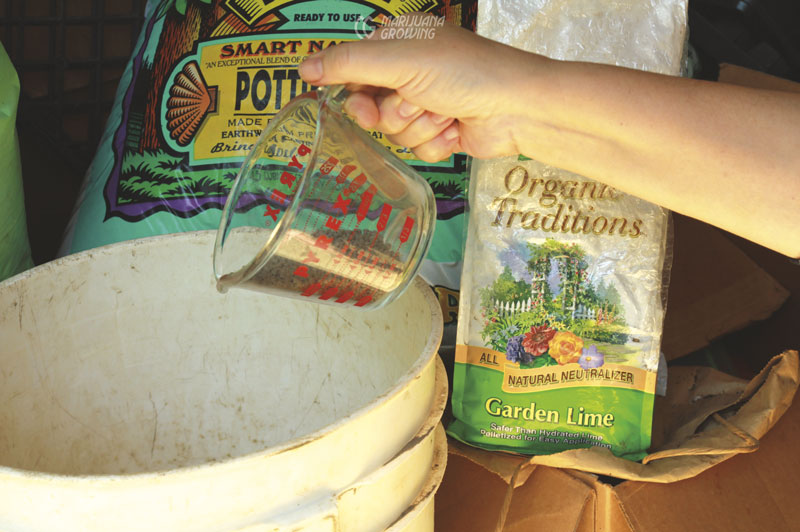
Agricultural lime
Raising Soil pH
The most common way to raise pH both outdoors and indoors is to incorporate lime into the soil (see descriptions below of different kinds of lime). Other materials that raise soil pH include pulverized eggshells, clam and oyster shells, and wood ashes, all of which have a high pH. Both eggshells and oyster shells decompose extremely slowly and are not recommended. Wood ashes, with a pH of 9.0 to 11.0, are easy to overapply. They are also soluble and wash from soil quickly. Wood ashes from fireplaces are often adulterated with contaminants that are not plant-friendly.
Cannabis is a well-known accumulator plant that takes in heavy metals and sequesters toxins in vacuoles, which are impermeable. The heavy metals remain toxic. Cannabis was planted around Chernobyl, the toxic nuclear site in Russia, to absorb toxic radioactive heavy metals.
Agricultural Lime (aka Aglime, agricultural limestone, or garden lime) is made from pulverized limestone or chalk. Calcium carbonate is the active component, but it may also include calcium oxide, magnesium oxide, and magnesium carbonate. Aglime raises pH and ads calcium and possibly magnesium and trace nutrients. Aglime is usually available in larger particle sizes and takes much longer than finer grades to affect soil pH.
Calcitic lime is calcium, CaCO3. Lime is calcium, calcium carbonate. Calcitic lime is just calcium, CaCO3. Dolomite lime, on the other hand, is calcium and magnesium, CaMg(CO3)2. If soil needs magnesium, apply dolomite lime. But many soils contain an adequate level to an abundance of magnesium but insufficient calcium and therefore require calcitic lime. Granular and coarse lime reacts slowly in soil. Apply lime to soil in the fall so that it has time to react. If applied in the spring it will not change pH for several months.
Dolomite lime (calcium magnesium carbonate, CaMg(CO3)2) stabilizes pH and adds calcium and magnesium. As long as it is thoroughly mixed into the soil, it is difficult to overapply. Dolomite has a neutral pH around 7.0 and does not raise the pH beyond 7.4, the upper range for carbonates. It stabilizes the pH safely. Compensate for acidic soil by mixing dolomite with soil before planting. It will buffer the pH, keeping it stable when applying mild acidic fertilizers. Dolomite does not prevent toxic-salt accumulation caused by impure water and fertilizer buildup. A proper fertilizer regimen and regular leaching helps wash away toxic salts. When purchasing, look for dolomite flour (powder), the finest fast-acting dustlike grade available. Coarse dolomite could take a year or more before it affects soil pH. Mix dolomite flour thoroughly with the growing medium before planting. Improperly mixed, dolomite will stratify, forming a cake on the soil surface or a subterranean layer that burns roots and repels water. Lime is sold as a grade of fineness with a sieve size of 10 to 100. When using different grades, the amounts are also adjusted, since 3000 pounds of coarse lime may equal 1000 pounds of a fine grade.
Hydrated or slaked lime (calcium hydroxide, Ca(OH)2) contains mainly calcium and might contain magnesium. It is improperly referred to as hydrated lime and is actually hydroxide of lime. As the word hydrated implies, this lime is water-soluble. Hydrated lime is more caustic (quickly burns skin) than quicklime and is usually made by adding water to burnt lime, forming a hydrate. It absorbs water readily from the air, and as a result becomes increasingly difficult to handle. Fast-acting hydrated lime alters pH quickly, but the results last about 2 weeks and it is caustic enough to burn skin. If you decide to use it, be very careful. Mix it thoroughly with warm water, and for fast results apply small amounts with each watering. At most, use a mix of 0.25 cup (6 cl) hydrated lime and 0.75 cup (18 cl) dolomite lime. Any larger quantity will toxify soil and stunt or kill plants.
Hydrated lime is immediately available, whereas the slower acting dolomite buffers the pH over the long term. My favorite use of hydrated lime is for a garden room fungicide. Sprinkle it on the floor and around the room. It also is used as a fungistat, killing fungus on contact.
Quicklime (calcium oxide, CaO) is made by burning rock limestone in kilns. This highly caustic lime should never be used in the garden. Quick-lime reacts with water, yielding slaked (calcium hydroxide) lime. Organic certification agencies prohibit the use of quicklime. Although fast-acting, the effect is short lived and it does not have the buffering abilities of dolomite lime.
Gypsum (calcium sulfate, CaSO4·2(H2O) is the “magic ingredient” in many soil mixes. It is an amendment, conditioner, and fertilizer. Gypsum lowers the pH of sodium-rich soils and lowers the level of exchangeable sodium. It can also raise soil pH, albeit slowly. Here is a great link about gypsum: www.usagypsum.com/agricultural gypsum.aspx. See chapter 12, Outdoors, and chapter 13, Case Studies, for more information.
Do not mix fast-acting hydrated lime and fertilizer. At best, acidic fertilizers will cancel the effects of lime. For example, urine is slightly acidic. When it is dispersed into a toilet that was recently cleaned with bleach, which is very alkaline, it results in an unpleasant odor and neutralizing reaction. The same is true with fertilizers.
To raise pH 1 point, add 3 cups (65 cl) of fine dolomite or agricultural lime to 1 cubic foot (30 L) of soil. An alternate fast-acting mix would be to add 2.5 cups (590 cl) of dolomite and 0.5 cup (12 cl) of hydrated lime to one cubic foot (28.3 L) of soil.
| Guidelines to raise soil pH from 5.5 to 6.5 in different types of soil: | ||
|---|---|---|
| Soil Type | kg/m2 | lb/yd2 |
| clay | 0.9 | 1.67 |
| sand | 0.7 | 1.29 |
| silt | 0.8 | 1.47 |
| organic | 1.1 | 2.03 |
| peat | 1.7 | 3.13 |
| POUNDS OF ELEMENTAL SULFUR NEEDED TO LOWER THE PH OF A LOAM SOIL TO A DEPTH OF SIX INCHES | ||||||
|---|---|---|---|---|---|---|
| Current pH | Desired pH | |||||
| lb per 100 ft2 | kg per 9.3 m2 | 6.5 | 6 | 5.5 | 5 | 4.5 |
| 8 | 3.62 | 3 | 4 | 5.5 | 7 | 8 |
| 7.5 | 3.4 | 4 | 3.5 | 4.5 | 6 | 7 |
| 7 | 3.17 | 1 | 2 | 3.5 | 5 | 6 |
| 6.5 | 2.94 | 1 | 2.5 | 4 | 4.5 | |
| 6 | 2.72 | 1 | 2.5 | 3.5 | ||
Lowering Soil pH
Soils with a pH above 7.0 are generally considered alkaline and must be lowered to accommodate robust cannabis growth. Use sulfur in the form of iron sulfate or magnesium sulfate to lower pH. Sulfur is readily available at nurseries or garden centers in geographic areas with high-pH soil. Do not confuse “elemental sulfur” (iron sulfate and magnesium sulfate) with sulfur used as a “plant nutrient.” Aluminum sulfate is often recommended because it lowers pH instantly as it dissolves in the soil. Cannabis can tolerate very little aluminum. Do not use aluminum sulfate. Other acids in liquid, crystal, and powder form can be used to lower pH, but they kill soil life in organic soil and are not advised. See chapter 23, Container Culture & Hydroponics, and chapter 20, Water, for more information.
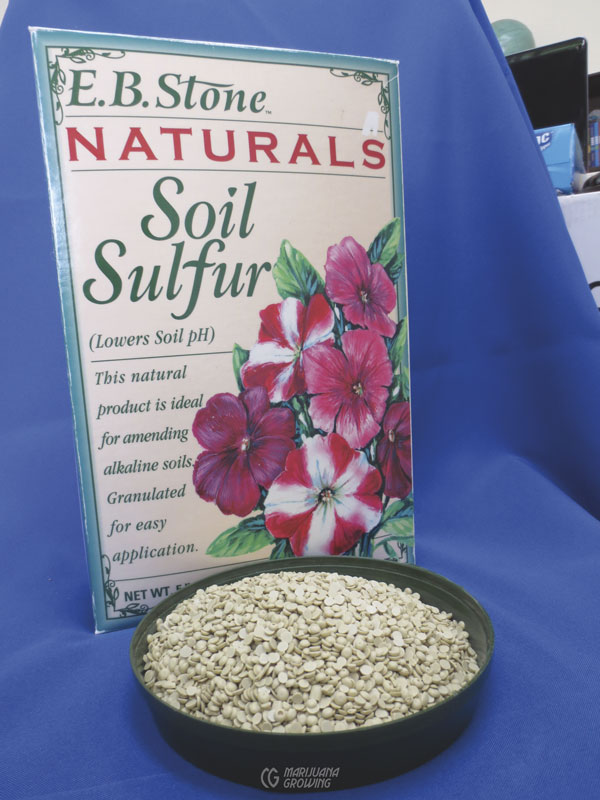
Sulfur is used to lower soil pH.
Soil Temperature
Heating Soil
The biological processes for nutrient transformation and availability are controlled by soil temperature and moisture. Raising the soil temperature speeds the chemical process and can hasten nutrient uptake. Ideally, the soil temperature should range from 65°F to 70°F (18°C–21°C) for the most chemical activity. However, microorganisms living in the soil are very active within a temperature range of 80.6oF to 89.6°F (27°C –32°C).
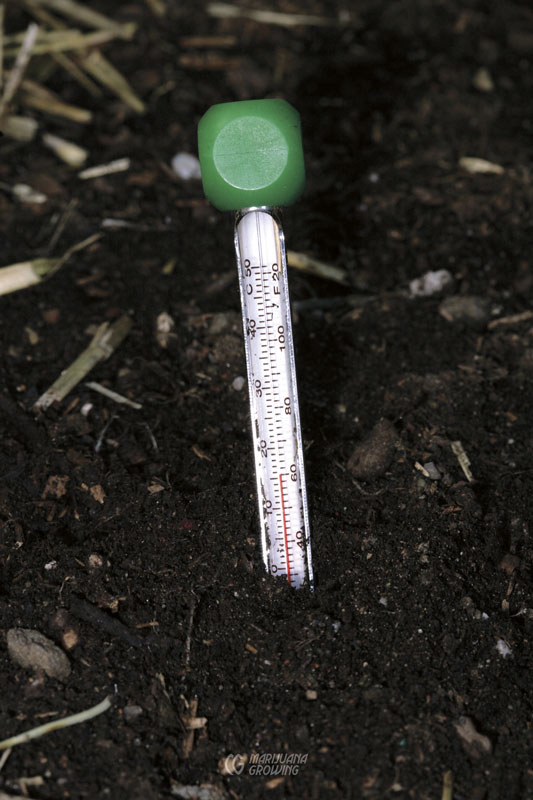
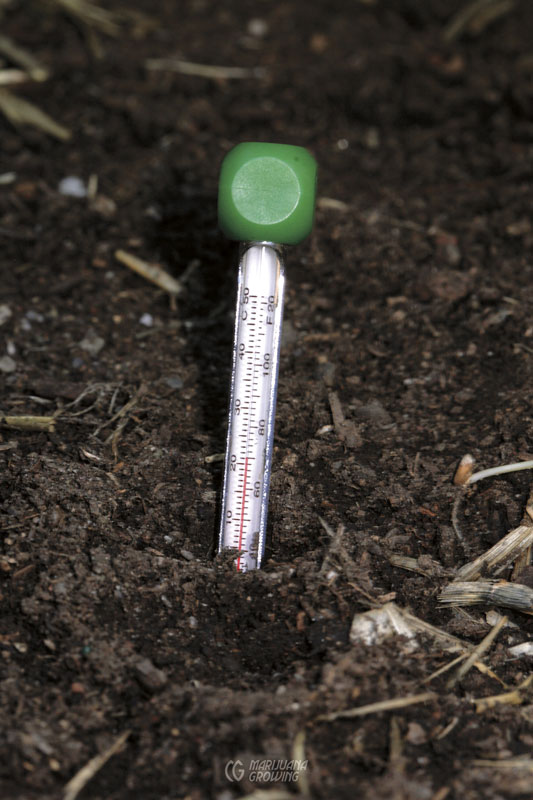
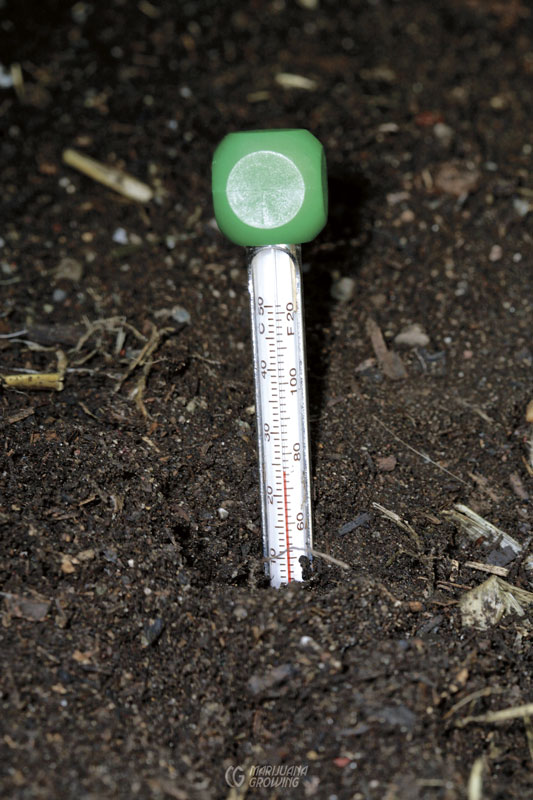
Each image of the thermometer was taken in sequence, an hour apart. Note how the temperature of the soil climbs from 60oF (15.5oC) to 75oF (24oC) in just 2 hours. High soil temperatures stifle growth.
Raised beds and containers that are 6 inches (15.2 cm) or more above ground level are affected by ambient air temperature and thus stay warmer. With raised beds, gardeners can plant 4 to 6 weeks earlier and can grow 4 to 6 weeks later in most climates. See chapter 12, Outdoors, for more information.
Direct sunlight shining on raised beds and containers heats outside margins quickly. Shade your garden beds and pots to avoid overheating them. Ambient temperatures above 92°F (33.3°C) cause excessive vapor pressure within the roots, which can cause damage. At high temperatures roots send stress signals to shut down much chemistry in leaves before damage can occur.
Soil temperatures that climb above 75°F (24°C) dehydrate roots, and at higher temperatures the roots literally cook! It is relatively easy to heat the soil in a pot. If the artificial light or any heat source is too close to small pots, it can easily heat up the outside layer of soil where the majority of the feeder roots are located. Once destroyed, roots take at least 2 weeks to grow back. When growing a cannabis crop that takes 8 weeks to flower, 2 weeks accounts for a quarter of the flowering cycle. Even the color of the container, such as black or white, will change the rate at which the growing medium warms.
Use soil-heating cables or a heating pad to warm soil in containers. Fasten heating cables to a board or table and set a heat-conducting pad on top of the cables to distribute heat evenly. Set cuttings and seedlings in shallow flats or growing trays on top of the heat-conducting pad. The added heat speeds root growth of clones and seedlings when soil temperature is below 65°F (18°C). Carefully monitor soil heat so that it does not climb beyond 70°F (21°C). To control heat more precisely, it may be necessary to attach heating cables and pads to a timer that turns them on and off at 15- to 30-minute intervals.
Soil heating cables cost less than soil heating pads but must be mounted on a board, whereas the pads are ready to use. Most commercial nurseries carry cables, and hydroponic stores carry heating pads.
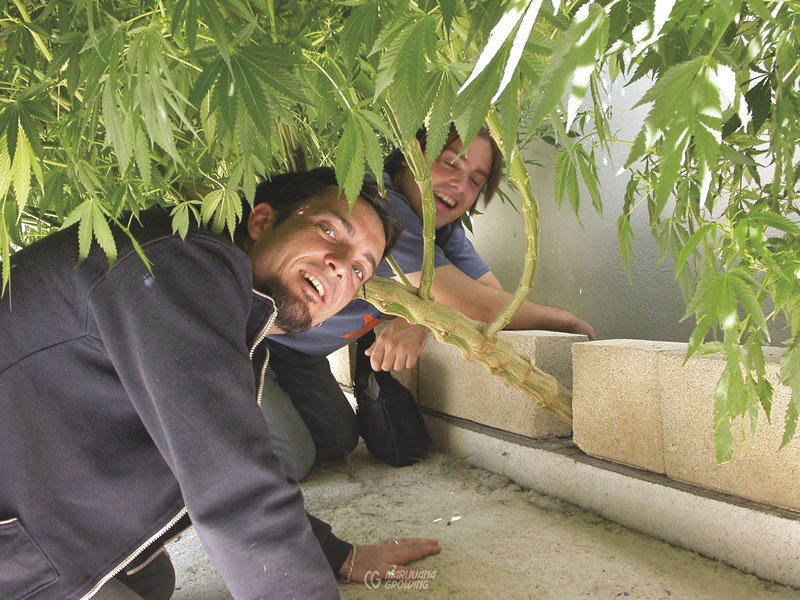
Bricks and a white stone wall supply additional heat to this large cannabis plant.
Cooling Soil
Unless measures are taken, soil in containers heats to the ambient level of garden rooms and greenhouses, especially when there is little deviation between day and nighttime temperatures. To cool soil naturally, set containers on cold concrete or earthen floors. They will stay nearly as cold as the concrete or earth, which is usually cooler than the ambient temperature. Keep garden room temperatures below 75°F (24°C) to help keep containers cool. Irrigating containers with cool water will also help cool the soil.
Outdoors and in greenhouses, soil in containers that receive direct sunlight warms rapidly to dangerous levels that cook roots. Set containers inside other containers to insulate soil from blazing sunshine. Or insulate containers with Styrofoam or a similar material.
Cold soil, below 50°F (10°C), slows water and nutrient uptake and stifles growth. Gardeners often overwater when the soil is too cold, which further slows growth and can waterlog roots. Damage to roots often goes unnoticed. Even if realized immediately, however, plants could take 2 or more weeks to recover. Root temperatures below 40°F (4°C) make water expand, which causes cell damage and stifles growth.
Increase soil temperature by moving pots up off the floor a few inches. Set them on an insulating board or piece of Styrofoam. Use soil heating cables or pads if necessary.
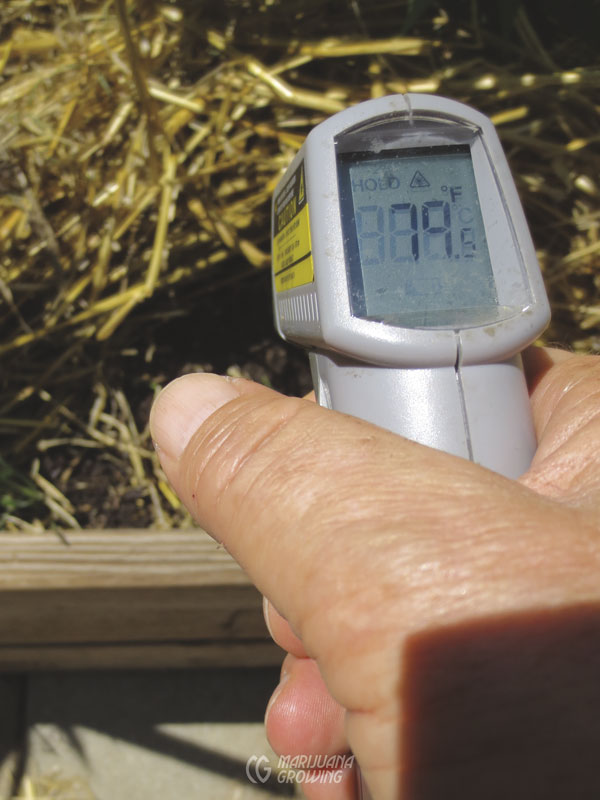
A 6-inch (15 cm) layer of straw mulch on top of the soil cooled the soil surface from 120oF to 79oF (49oC–26oC).
Soil Amendments
Soil amendments increase the soil’s air-, water-, and nutrient-retaining abilities. Amendments with a high CEC rating hold nutrients and water well and release them as needed. Soil amendments fall into 2 categories: mineral and organic.
Mineral amendments are near neutral on the pH scale (7.0) and contain few, if any, available nutrients. Mineral amendments decompose through weathering and erosion. They have the advantage of creating no bacterial activity to alter nutrient content and pH of the growing medium. Dry mineral amendments are also very lightweight and much easier to move in and out of awkward spaces.
Perlite works especially well for aerating the soil. This is a good medium to increase drainage during vegetative and flowering growth. Perlite has a low CEC rating, and it does not promote fertilizer-salt buildup. See chapter 23, Container Culture & Hydroponics, for more information on perlite.
Expanded clay pellets (calcined clay, hadite, Hydroclay, and similar fired clay products) expedite drainage and hold air within the growing medium. See chapter 23, Container Culture & Hydroponics, for more information on expanded clay.
Sand is heavy and has a low CEC rating. Use no more than 10 percent as a soil amendment because it tends to wash into pockets. Sand will also accumulate on soil surface. See chapter 23, Container Culture & Hydroponics, for more information on sand.
Vermiculite is a good soil amendment to hold moisture, but if used in large quantities it can be very expensive. It is rich in potassium (K) and magnesium (Mg). It has a high CEC rating and holds water, nutrients, and air within its fiber, and it gives body to fast-draining soils. Alone, fine vermiculite holds too much water for cuttings but works well when mixed with a fast-draining medium. See chapter 23, Container Culture & Hydroponics, for more information on vermiculite.
Organic Soil Amendments
Organic soil amendments overall have a high CEC rating. They contain carbon, and they break down through bacterial activity, slowly yielding humus as an end product. Humus is a soft, spongy material that binds minute soil particles together, improving the soil texture and increasing nutrient uptake.
New, actively composting organic soil amendments require nitrogen to carry on bacterial decomposition. Organic amendments are not always well composted and often contain high, even toxic, levels of salts. Check bulk amendments/fertilizers/soils with a sodium (Na) meter to ensure that they contain less than 50 ppm of sodium.
Amendments must contain at least 1.5 percent nitrogen or they will “rob” nitrogen from the soil. When using organic amendments, make sure they are thoroughly composted (at least 1 year) and releasing nitrogen rather than pilfering it from the soil. A dark, rich color is a good sign of fertility.
At a reputable nursery, purchase quality organic amendments that are OMRI-approved* (or approved by a similar third-party organic-certifying agency). Look carefully at the descriptive text on the bag to see if the contents are sterilized and guaranteed to contain no harmful insects, larvae, eggs, and fungi or bad microorganisms. Contaminated soil causes many problems that are easily averted by using a clean mix.
*Organic Materials Review Institute (OMRI) is the premier independent agency that provides organic certification for growers, manufacturers, and suppliers in North America. Check for a similar agency in your country. You can find more information at www.omri.org.
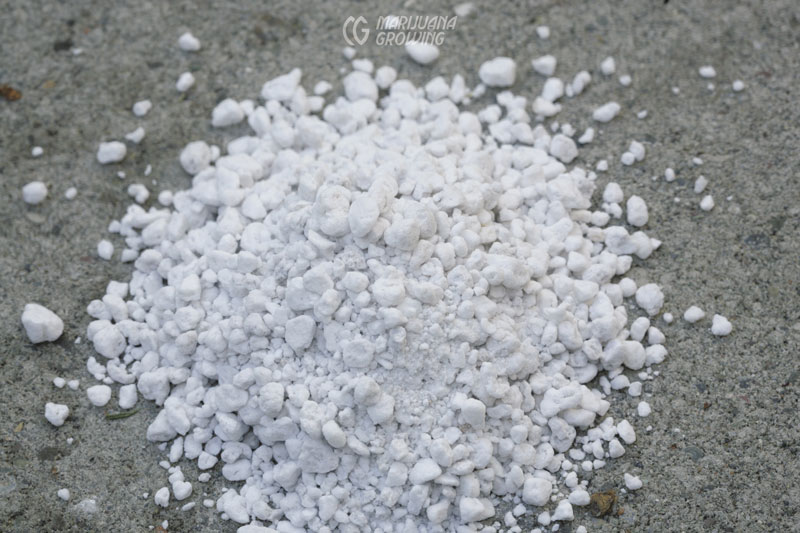
Perlite
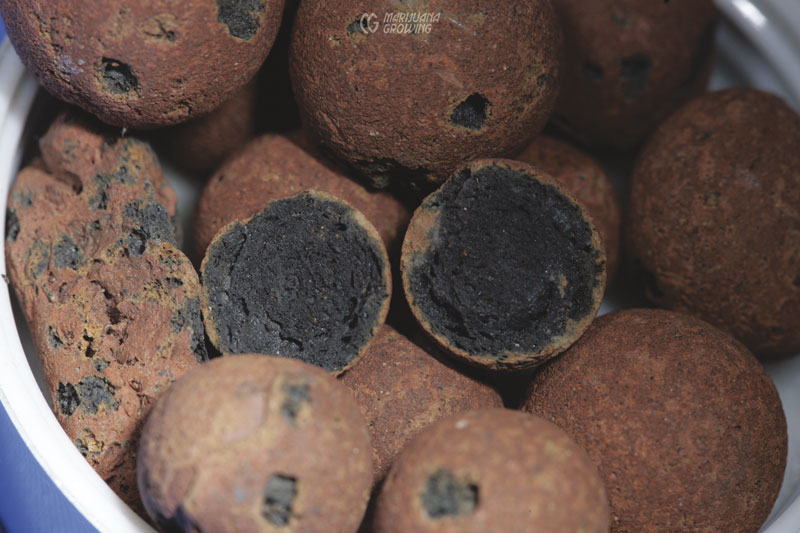
Expanded clay pellets
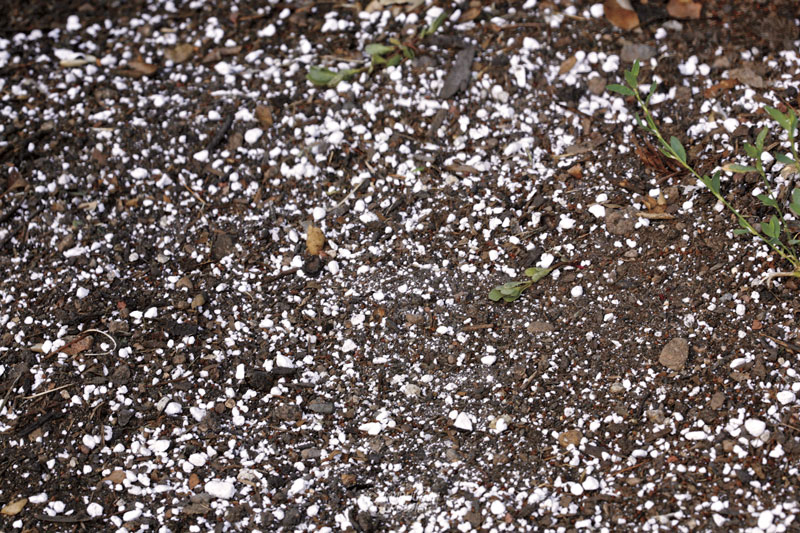
Vermiculite is available in fine, medium, and coarse grades.
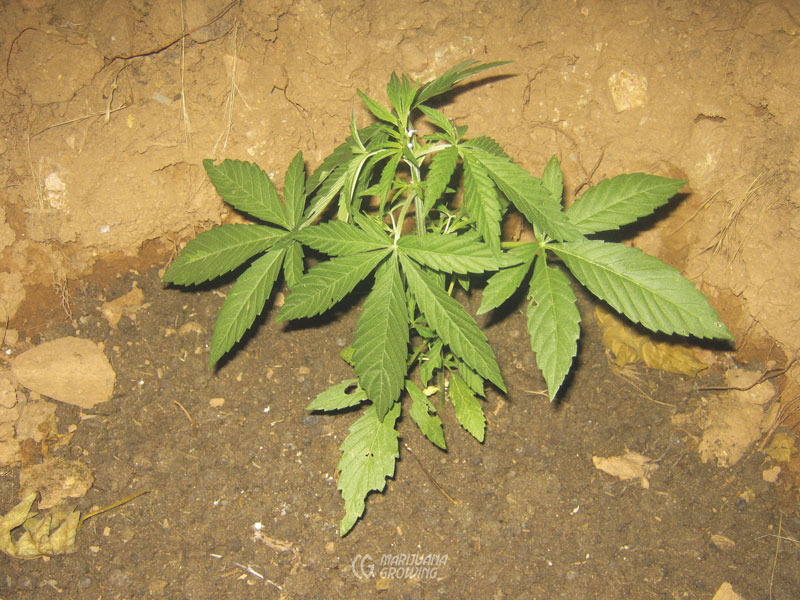
A little organic soil amendment can help immensely. Just make sure the planting holes are big enough so that heavy clay soil does not restrict root growth.
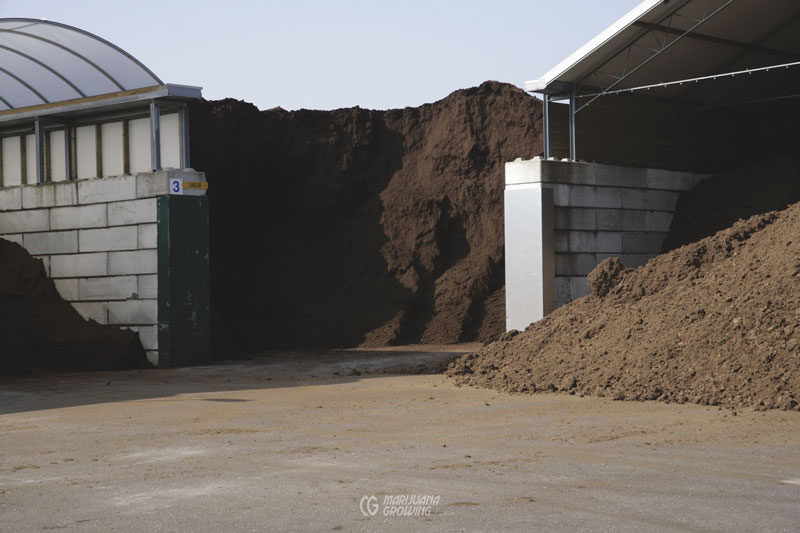
Mountains of peat-based soil—seen here at the Gold Label facility in the Netherlands—are awaiting processing into top-quality grow medium mix.
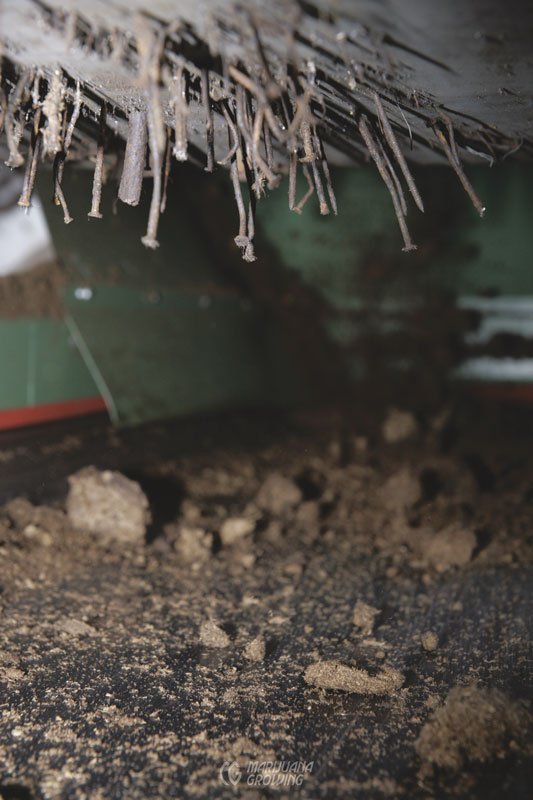
A big, powerful magnet removes an incredible amount of ferrous metals from soil before processing. Check your soil for ferrous metals by rolling a magnet around in it for a few minutes. You may be surprised.
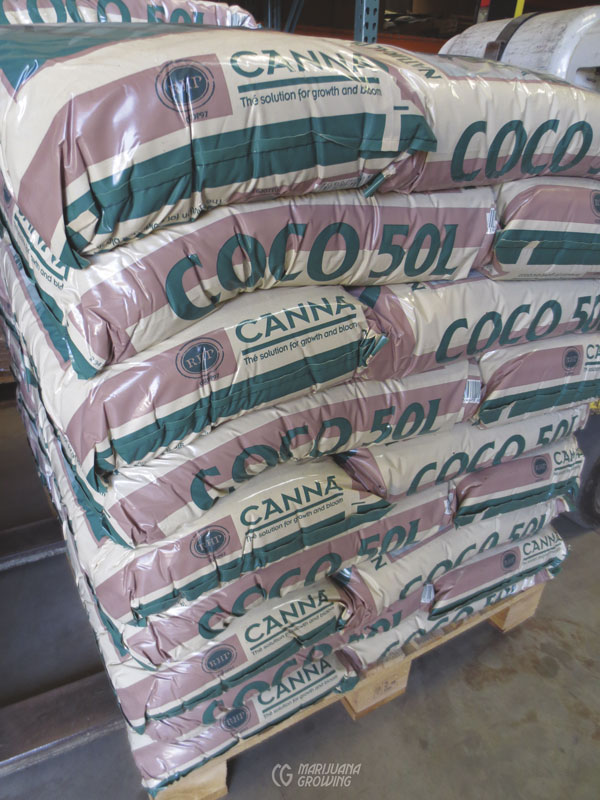
Coco coir was popularized in the cannabis cultivation industry by Canna, a Dutch company that continues to lead the industry.
Buyer beware! Batches of commercially available soil and amendments are not always mixed consistently. Weather—heat, cold, rain—diseases, and pests can also alter the content of bulk and bagged potting soils that are exposed to such elements. Often when a company has a big demand for their products, they do not have enough bulk materials to mix the soil and therefore include second-class materials that are not completely composted or that contain high levels of salts.
Organic amendments break down after a year or less of use, losing much of their volume and becoming compacted. They also become contaminated. If reusing amended soil, see “Recycling Potting Soil,” on page 320, for guidelines.
Bark chips, bark dust, and wood fiber are acidic and may use available nitrogen in the soil to decompose. Mycorrhizal fungi, Trichoderma, and many other decomposers break down bark chips. In general, cannabis prefers bacterial activity rather than fungal activity in the soil. There is virtually no CEC in the bark chips until after the breakdown into organic acids and such. Bark chips work well to impart antiseptic activity and increase airspace.
Coconut fiber is an excellent soil amendment because it holds so much water and air at the same time. Add it to garden soil or organic mineral soil container mixes. Many gardeners prefer inexpensive coco that has been pressed into bricks because they are easy to store and transport. See chapter 23, Container Culture & Hydroponics, for more information on coco.
Compost and leaf mold have a medium to high CEC and are usually rich in organic nutrients and beneficial organisms that speed nutrient uptake. When not allowed to heat to 160°F (71°C), compost can be full of harmful pests and diseases. A single cutworm in a container can kill a defenseless plant before migrating to another pot. Be extremely careful when using outdoor compost indoors.
Well-composted organic matter amends texture and supplies nutrients. Leaf mold, garden compost (at least 1 year old), and many types of thoroughly composted manure usually contain enough nitrogen for their decomposition needs and release nitrogen rather than using it.
Mushroom compost is an inexpensive soil amendment with a high CEC, and it is full of nutrients. Mushroom compost is sterilized chemically to provide a clean medium for mushroom growth. After serving its purpose as a mushroom growing medium, it is discarded. On average, mushroom compost contains low levels of nitrogen (N), potassium (P), potash (K), calcium (Ca), magnesium (Mg), and iron (Fe).
By law, mushroom compost is required to sit fallow for 2 years or more to allow all the harmful sterilants to leach out. After lying fallow for several years, mushroom compost is very fertile and contains many beneficial microorganisms. Check your local nursery or extension service for a good source of mushroom compost. Some of the most abundant harvests I have seen were grown in mushroom compost.
Manure: Barnyard manure, a great fertilizer for outdoor gardens, often contains toxic levels of salt and copious quantities of weed seeds and fungus spores that disrupt an indoor garden. If using manure, purchase it in bags that guarantee its contents. There are many kinds of manure: cow, horse, rabbit, and chicken, to name a few. When mixing manures as amendments do not add more than 10 to 15 percent to avoid salt buildup and overfertilization. Manures purchased in bulk should be checked with a sodium (Na) meter to ensure they do not contain excessive amounts (more than 50 ppm). The nutrient content of manures varies depending upon the animal’s diet and the decomposition factors.
NOTE: Green or fresh manures require composting for a minimum amount of time, based on the animal source, and can range up to five years with chicken manure. Ammonium levels will be very high until composting occurs.
See “Manure” in chapter 21, Nutrients, for more information on manures and other additives.
Peat is one of the most common soil amendments both in container (soil-less and soil) gardens and outdoor soil gardens. Although bulky, large bags and compressed bales of peat are available virtually everywhere at a fair price. See chapter 23, Container Culture & Hydroponics, for more information on peat.
Soil Mixes
Outdoor soil mixes that incorporate garden soil, compost, manure, coco peat, and rock powders can grow some of the biggest and best cannabis plants in the world. These outdoor soil mixes should be prepared a few months in advance and left in the planting hole to blend and mature. It’s important to note that outdoor organic soil mixes are rich in microbial life, which contributes to healthy plant growth.
The following recipes for complete organic fertilizers (COF) and soil mixes for growing medicinal cannabis organically are provided by an experienced gardener. These recipes are suitable for indoor, outdoor, and greenhouse container cultivation. Be sure to mix the components thoroughly before applying.
Organic Soil Mix
All measurements are by volume
- 1/3 best organic garden soil
- 1/3 coco coir hydrated with a strong commercial fertilizer solution such as Canna Terra Vega
- 1/3 well-rotted, sifted organic compost
To each 5 gallons (19 L) of mix, add 1 cup (237 ml) of COF.
Complete Organic Fertilizer (COF) Mix
- 1 quart (1 L) high-calcium aglime
- 0.5 quart (0.5 L) gypsum
- 1 quart (1 L) soft rock phosphate
- 0.33 cup (78 ml) potassium sulfate
- 3 quarts (3 L) canola seed meal
- 2 teaspoons (10 ml) borax or a smaller quantity of Solubor (1 gm actual boron)
- 1 teaspoon (5 ml) zinc sulfate
- 1 teaspoon (5 ml) manganese sulfate
- 2 teaspoons (10 ml) iron sulfate
- 0.5 teaspoon (2.5 ml) copper sulfate
- 1 quart (1 L) kelp meal
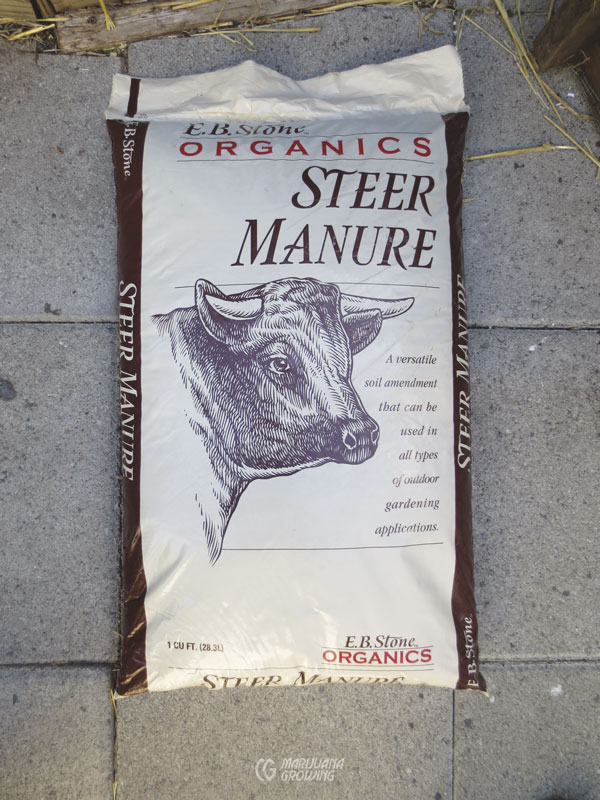
Steer manure contains low levels of nutrients and is an excellent soil amendment.
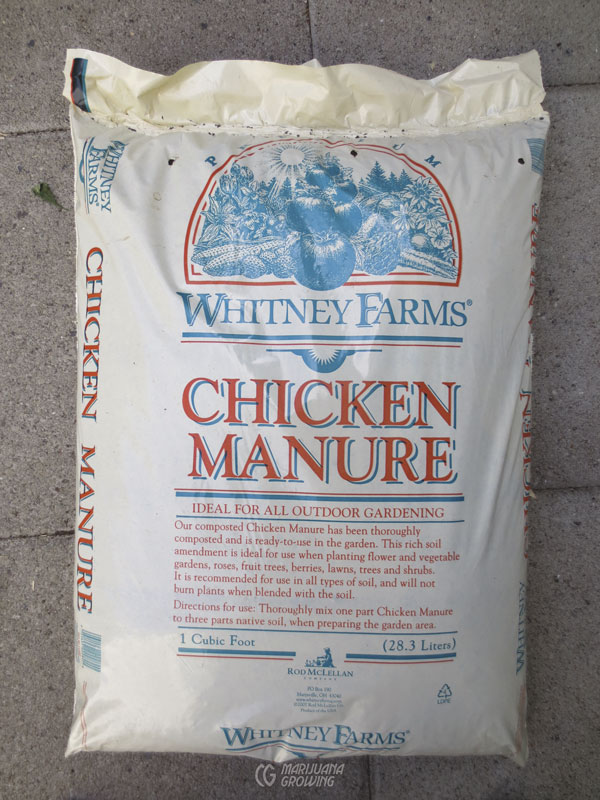
Well-composted chicken manure is a favorite organic fertilizer and soil amendment.
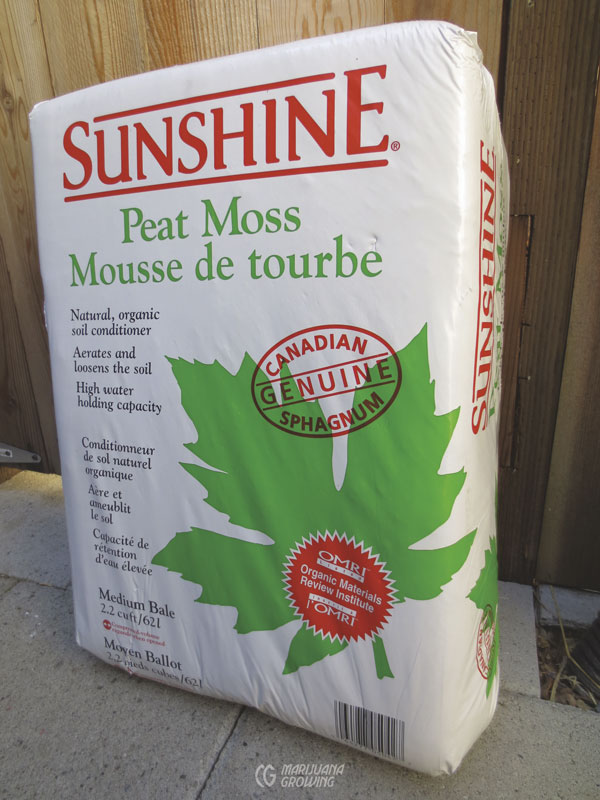
Well-composted chicken manure is a favorite organic fertilizer and soil amendment.
Lime: Do not use dolomite lime! Use only high-calcium lime and avoid magnesium. Fineness of grind is essential. Use 100-mesh screened lime.
Soft rock phosphate (SRP) is also essential. It is by far the best form that is acceptable to organics. The source of SRP is Nutri-Tech Solutions, www.nutri-tech.com.au.
Boron: Borax is 10 percent boron. At 2 teaspoons at a time, 1 kilogram of Borax from the supermarket might last months. Solubor supplies 20 percent boron, but if used, you need to calculate how much of it is needed to deliver 1 gram of actual boron.
Zinc sulfate is deliquescent; it absorbs moisture from the air and turns into a sloppy mess. Avoid such problems by storing it in an airtight container.
Measuring: There are 2 “dangerous” elements in this mix: boron and copper. These must be measured very accurately.
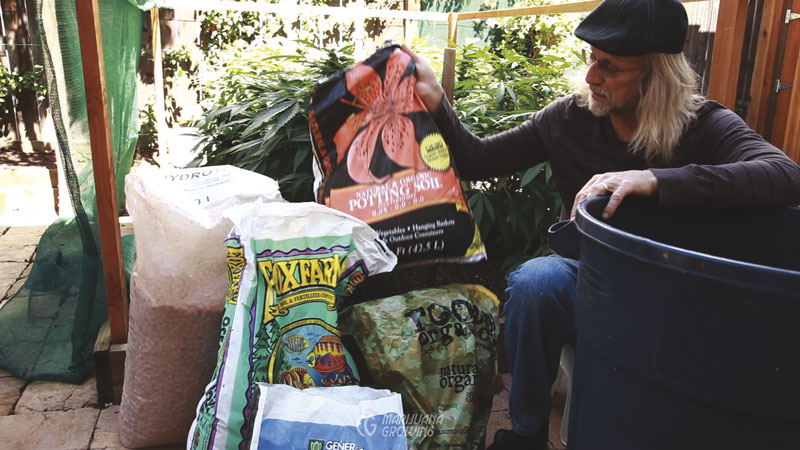
Mixing soil is best done outdoors or in an open area.
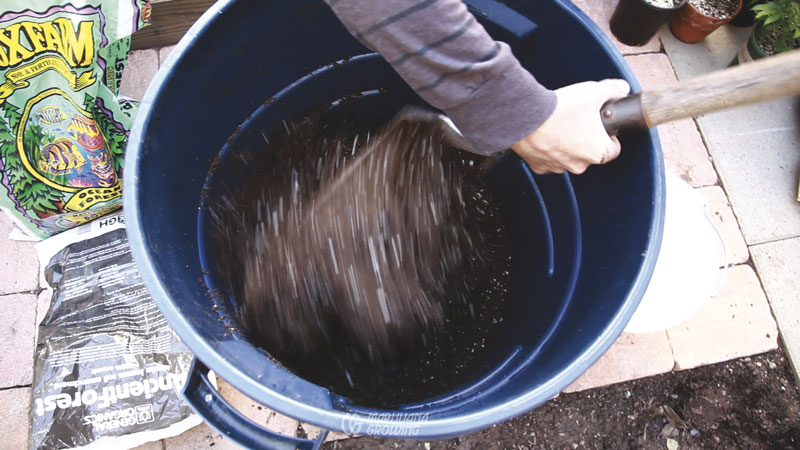
Blend soil in a large container.

This healthy plant is the product of a good soil mix in a large container.
Tom Hill Mix
This mix was given to me by Tom Hill, a Northern California medical cannabis gardener. The mix is for 50 cubic feet (1,416 L) and will fill six, 300-gallon (1,136 L) containers.
25 bags, 1.5 cu ft each (42.5 L) of quality organic potting soil
4 cu ft (113.3 L) chicken manure
4 cu ft (113.3 L) perlite
50 lb (22.7 kg) steamed bone meal
20 lb (9 kg) gypsum
See “Brix Mix” in chapter 21, Nutrients.
There are many more soil mixes listed on our website forum. Check out www.marijuanagrowing.com.
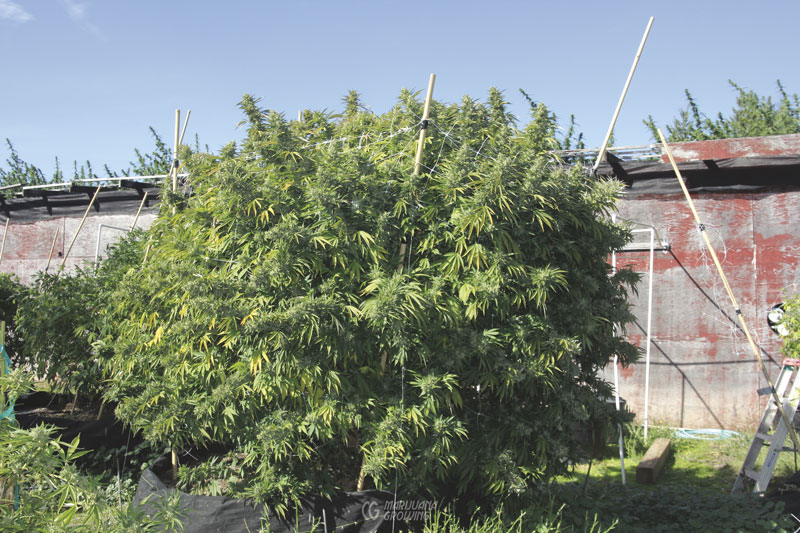
Tom is an excellent gardener, and you can see that his soil mix grows big, strong, healthy plants!
In indoor gardens and greenhouses, outdoor soil mixes often create problems. Soil dug up in the backyard and used to fill containers usually drains poorly and retains too much water and not enough air. Problems are compounded when this soil is mixed with garden compost that is full of harmful microorganisms and pests. The end results are low yields and possible crop failure.
Avoid soil-mix problems by purchasing all the components in sealed plastic bags. Use garden soil or compost only if they are top quality and devoid of harmful pests and diseases. Use only the richest, darkest garden soil with a good texture. Amend the soil to improve water and nutrient retention and drainage.
Solarize garden soil by setting it out in the sun in a plastic bag or a shallow 6-inch-deep (15 cm) bed and then covering it with plastic. Turn the bag occasionally to heat it up on all sides. Make sure the entire bag receives full sun and heats up to at least 160°F (71°C) for a minimum of 2 hours, or 120oF (49oC) for 3 to 4 weeks.
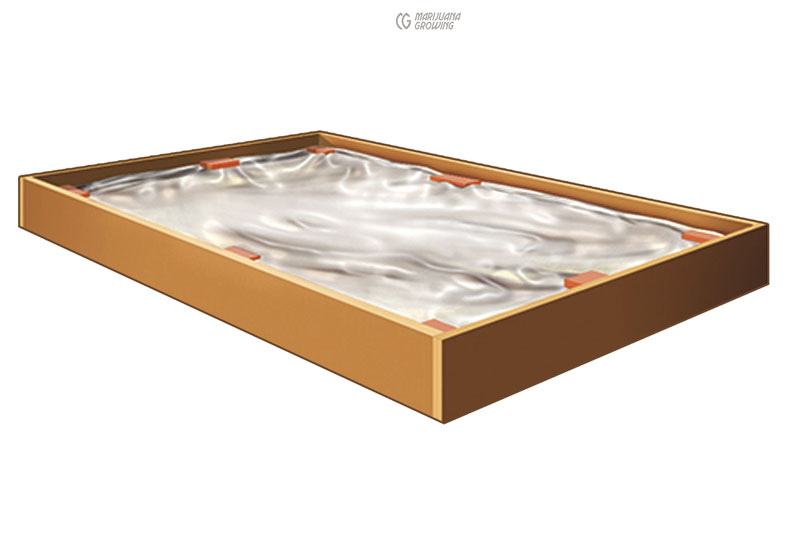
Solarizing soil will kill most all the undesirables.
Steam sterilization is the fastest sterilization method and is the method most commonly used by greenhouse professionals. It requires a strong source of steam that will completely permeate the medium, and the growing medium must be completely enclosed. Steam the medium so that it heats to at least 140oF (60oC) for at least 2 hours.
You can also sterilize soil by laying it out on a Pyrex plate and baking it at 160°F (71oC) for 10 minutes or microwaving it for 2 minutes at the highest setting. It is much easier to purchase quality potting soil at a nursery.
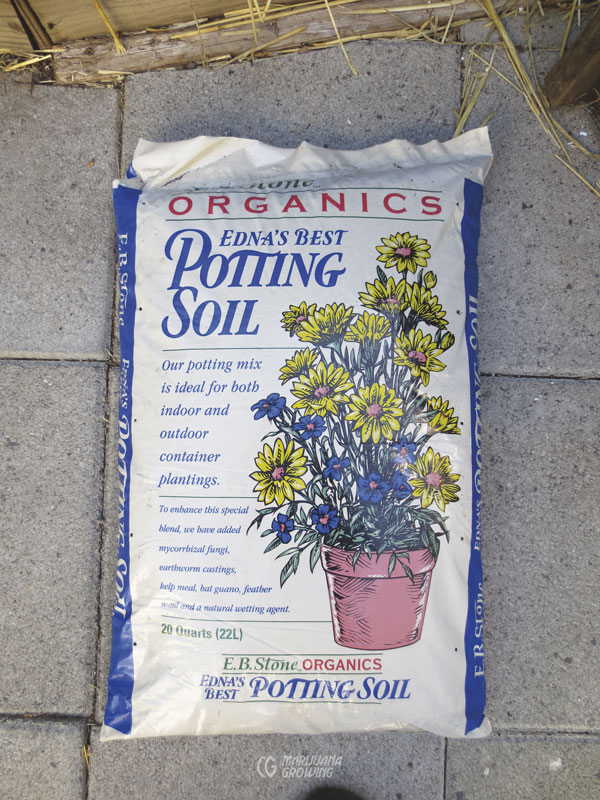
Organic potting soil is available from many different suppliers, with significant variation in quality.
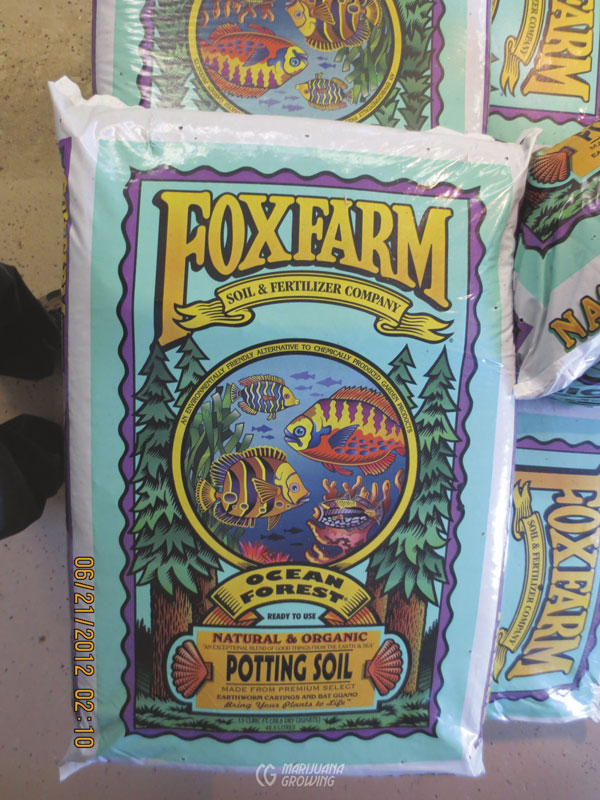
Regardless of the brand of potting soil, always check its pH and sodium level.
Potting Soil
Well-formulated, high-quality potting soil stored in a sealed bag frequently has the proper texture, a stable pH, and a small supply of nutrients. Often these soils are fortified with trace elements and also contain low levels of macro- and secondary nutrients. The proper porous texture allows good root penetration, water retention, and drainage. Agricultural lime or dolomite lime keeps pH stable. Many potting soils are formulated with a wetting agent to evenly retain adequate water and air. Avoid using potting soils for longer than 4 months, because their properties tend to degrade.
Since soil is heavy, transportation costs tend to keep it somewhat localized. Ask your nursery person for help in selecting a quality potting soil for fast-growing cannabis or annual flowers or vegetables.
Avoid potting soils with more than 10 percent tree bark or wood fiber. Potting soils in the eastern USA, for example, often contain high levels of wood fiber. Such soils with hold water well but their pH can fluctuate substantially. The size and shape of bark varies, and its decomposition by carbon and microbes is uneven. Furthermore, wood fiber requires nitrogen to decompose, which depletes the nitrogen intended for plants. Such soils also promote an environment that is conducive to perennial “woody” plant growth rather than herbaceous annual (cannabis) plant growth.
Buyer Beware! Potting soil that has been stored outdoors is subject to direct sunlight and moisture. Any life in the organic soil could easily be compromised. Holes or tears in the plastic let moisture and adulterants enter the bag of “sterile” potting soil.
Upon purchase, always check potting soils—bagged or in bulk—with a pH meter and a sodium (Na) meter to ensure that the pH is within a safe range to grow cannabis, and that it does not contain excessive sodium (more than 50 ppm).
Read the nutrient description on the label—carefully—before purchasing.
Mixing Potting Soils
Mixing custom potting soil saves you money, and it allows you to use specific amendments and fertilizers to reduce complications and their subsequent workload. See discussion of specific amendments in this chapter and “Fertilizers” in chapter 21, Nutrients.
Blend soil components when dry to evenly disperse them into the mix. Add a light spray of water to dampen dust. To give an example of how long to mix soil, a spoonful of fritted trace elements in a cubic yard (m^2) of soil requires at least 5 minutes of mixing by hand.
Caution! Fritted micronutrients are on glass particles. These are high in potassium and can overload the ratio. Sensitive cannabis varieties are easy to burn.
Here are two good soil mixes from Vic High, an expert medical cannabis gardener.
Vic High Mix #1
- 1 bail (3.8 cu ft [107 L]) Sunshine #2 or Pro-Mix or similar product
- 0.5 gallon (2 L) steamed bone meal – P
- 3.8 quarts (3.6 L) blood meal – N
- 1.3 cups (31 cl) Epsom salts – Mg
- 3.5 cups (83 cl) dolomite lime – Ca & Mg + buffering
- 1 tablespoon (17.8 ml) fritted trace elements
- 1 cubic foot (28.3 L) chicken manure – N + trace elements
Mix thoroughly, moisten, and let sit 1 to 2 weeks before use.
Vic High Mix #2
- 1 bail (3.8 cu ft [107 L]) Sunshine #2 or Pro-Mix or similar product
- 8 cups (1.9 L) bone meal
- 4 cups (1 L) blood meal
- 1.3 cups (31 cl) Epsom salts – Mg
- 3.5 cups (83 cl) dolomite lime – Ca & Mg + buffering
- 1 teaspoon (0.5 cl) fritted trace elements
- 4 cups (1 L) kelp meal
- 20 lb (9 kg) pure worm castings
Mix thoroughly, moisten, and let sit 1 to 2 weeks before use.
In regard to the above-listed ingredients, blood and bone meal are inexpensive sources of nitrogen and phosphorus. Kelp meal contains more than 60 available (trace) elements. Worm castings are also a great source of micronutrients. Bat guano is expensive; use sparingly as a top dressing during the first week of flowering.
Use a layer of sand on top of soil to quell fungus gnat growth. Or use fungus gnat predators (Hypoaspis miles); once established they control fungus gnats, thrips, and mites.
Caution! Do not use cheap or discounted low-quality potting soil. These soils can be full of weed seeds, pests, and diseases. In addition, they hold water unevenly and drain poorly. The latest trend in “cheap” potting soils is to use composted garbage in the mix. Ultimately, saving a few pennies on soil will cost many headaches, might result in lower yields, and can even cause crop failure. Most potting soils supply transplanted seedlings and clones with enough nutrients for the first 2 to 4 weeks of growth. After that, supplemental fertilization is necessary to retain rapid, robust growth.
Adding 0.5 cup (11.8 cl) per cubic foot (28.3 L) of fine-grade dolomite lime to buffer and stabilize the pH is a good garden practice.
Trace elements in fortified soil and soil-less mixes can wash out and should be replenished with chelated elements the instant deficiency signs occur. Organic gardeners often add their own blends of trace elements in mixes that contain seaweed (including kelp), guanos, and manures. However, be extremely careful not to overapply.
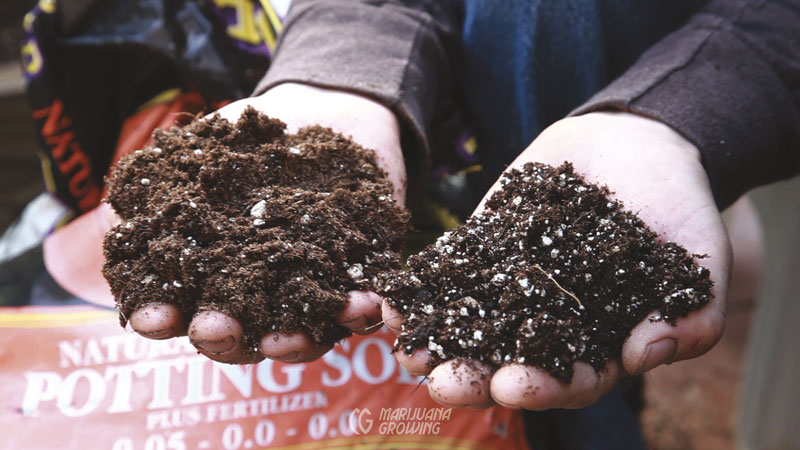
The difference between these potting soils is striking. The one on the right, with more perlite, drains best.
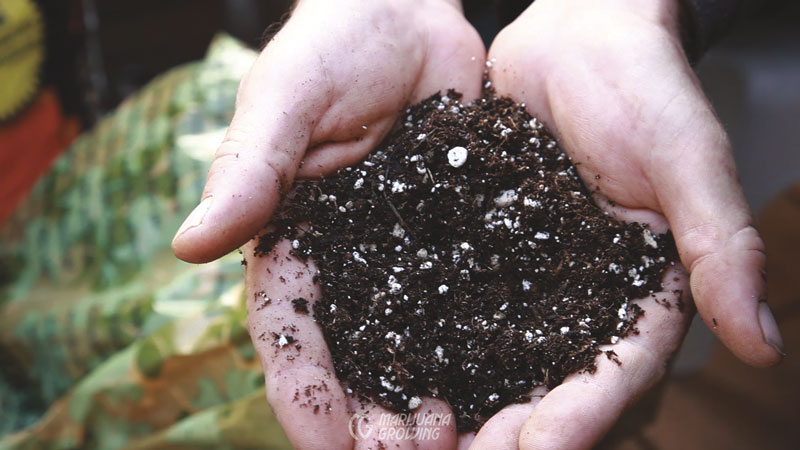
This soil mix is high in perlite and dark, rich elements. It will drain well and hold plenty of nutrients and water for plants.
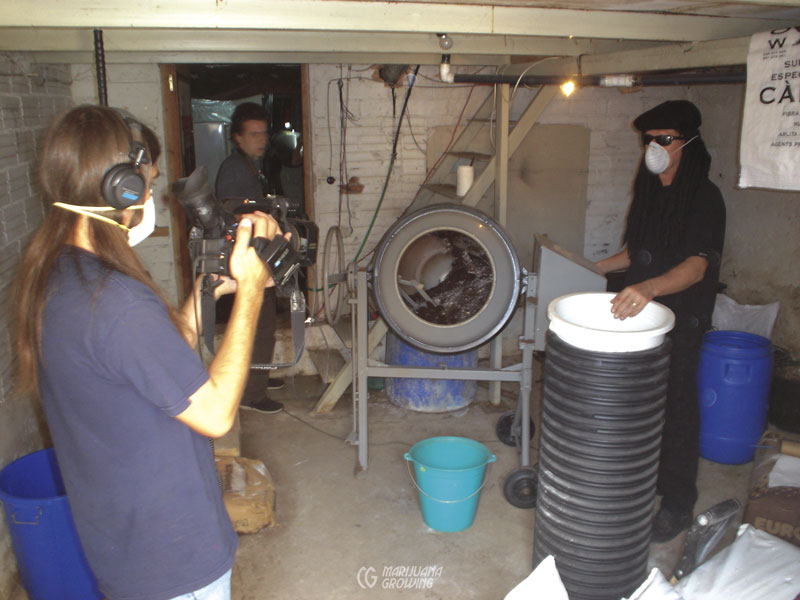
Rent a commercial cement mixer to mix large quantities of soil.
Recycling Potting Soil
At right is a recipe from Vic High for recycling soil used indoors and in greenhouses. Recycling potting soil may cause problems, the most common of which are pests and diseases, growing-medium compaction, and poor drainage. Recycling indoor and outdoor potting soil to use outdoors is much less problematic. The soil must be hot composted or sterilized with heat or steam to kill undesirable diseases and pests. Nutrients must be replenished too. New amendments often have to be added to increase water retention and to avoid compaction and undesirable CEC levels in most soils, but not necessarily in clay-based mineral soils. Carefully monitor and balance pH in peat-based soils.
Simply screening out roots or reusing the soil “as is” practically guarantees problems with pests and diseases. Even reusing half or a third of the old soil and adding new amendments can be problematic. For best results, the soil must be hot composted. Peat-based soils decompose and become more acidic. Fertilizer salt buildup is also a problem if the soil is not leached well enough with water.
Caution! Residual nitrogen that is hot composted will usually convert to the toxic nitrite form and kill the plants.
Organic soils rich in soil life can easily be mixed together and hot composted for 3 to 4 months. Once composted, mix the following into every 50 gallons (190 L) of soil.
- 2.5 cups (59 cl) dolomite
- 0.5 cup (11.8 cl) Epsom salts
- 2.1 quarts (2 L) bone meal
- 3.8 quarts (1 L) blood meal
- 3.8 quarts (1 L) kelp meal
- 1 teaspoon (0.5 cl) fritted trace elements
- Enough perlite to regain original drainage qualities
Outdoors: Used indoor soil makes excellent outdoor potting soil when broken up and mixed with compost. Let the soil compost outdoors for at least three months before using. Do not reuse depleted soil “as is” in outdoor pots. The same problems that occur indoors when reusing soil also happen outdoors.
Dry soil is lighter and easier to transport than wet soil. Cut stems off at or below the soil line before moving dry, used soil out to incorporate in the outdoor garden. If mixed into a vegetable or flower garden, simply remove used soil from containers and till it into the top few inches of garden soil. Drench soil with dilute dark food coloring so white perlite is not unsightly. White perlite in an outdoor garden could call unwanted attention to an indoor garden.

Even when planted in Mother Earth, the bulk of roots are located around the stem. Roots spread out quite a bit, but they are not usually as dense as with plants grown in containers.
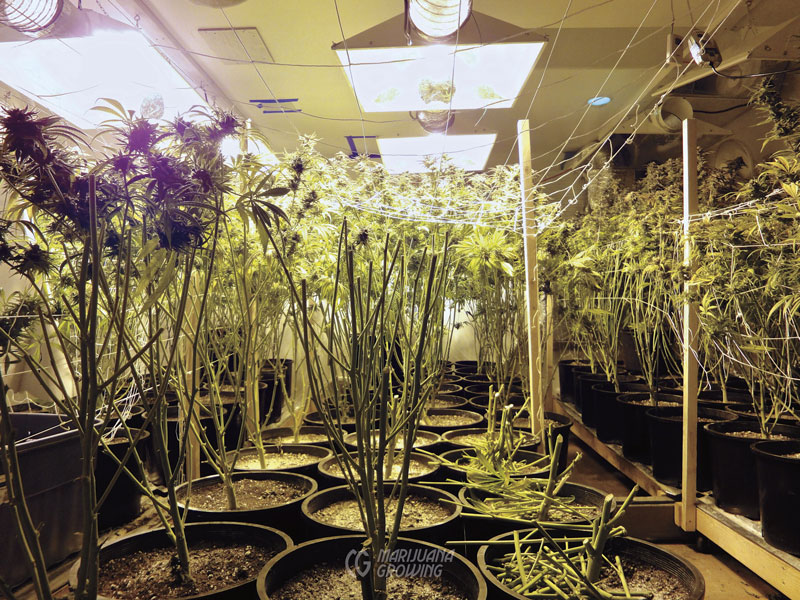
Soil from these indoor plants will be moved outdoors, and their stems will be ground up to be mixed into the outdoor garden soil.
Propagation Cubes and Pellets
Rockwool root cubes, peat pellets, and Oasis blocks are preformed containers that make it easy to root cuttings, start seedlings, and then transplant them. Root cubes and peat pots also help encourage strong root systems. Peat pots are small, compressed peat moss containers that have an outer wall of expandable plastic netting. When watered, a peat pellet pops up into a seedling pot.
Place a seed or cutting in a moist peat pot or root cube. If the little container does not have a planting hole, make one with a chopstick, large nail, or something similar. Set the seed or clone stem in the hole. Crimp the top over the seed or around the stem to ensure constant contact with the medium. In 1 to 3 weeks, roots grow and show through the side of the cube. Cut the nylon mesh from peat pots before it becomes entangled with roots. To transplant, set the peat pot or root cube in a predrilled hole in a rockwool block or into a larger pot. Clones and seedlings suffer little or no transplant shock when properly transplanted.
Check moisture levels in peat pots and root cubes daily. Keep them evenly moist but not drenched. Root cubes and peat pots do not contain any nutrients. Seedlings do not require nutrients for the first week or two. Feed seedlings after the first week, and feed clones as soon as they are rooted.
Coarse sharp sand, fine vermiculite, and perlite work well to root cuttings. Sand and perlite are fast draining, which helps prevent damping-off. Vermiculite holds water longer and makes cloning easier. A good mix is one third of each: sand, fine perlite, and fine vermiculite. Premade seed starter mixes sold under such brand names as Sunshine Mix and Terra-Lite are the easiest and most economical mediums in which to root clones and start seedlings. Soilless mix also allows for complete control of critical nutrient and root-stimulating hormone additives, which are essential to asexual propagation.
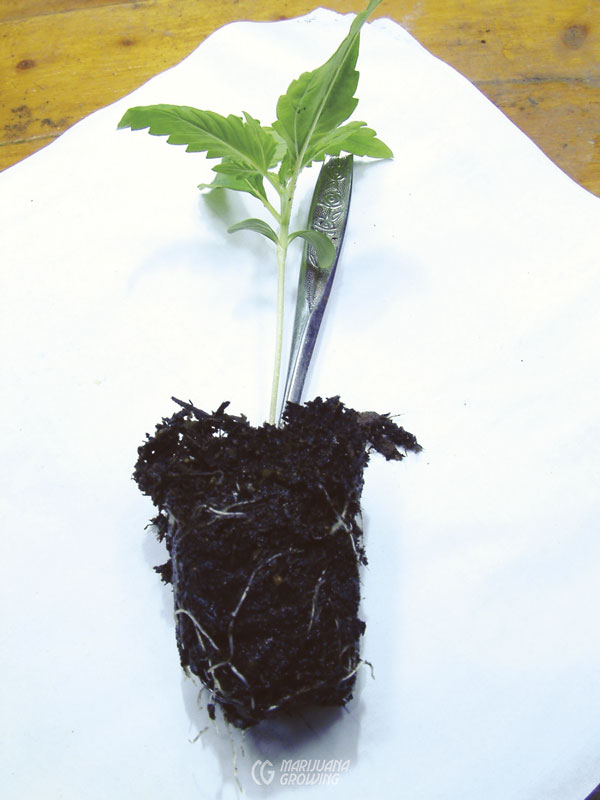
This little seedling was grown in a rooting flat along with 50 others. A spoon was used to lift it out of the container for transplanting.
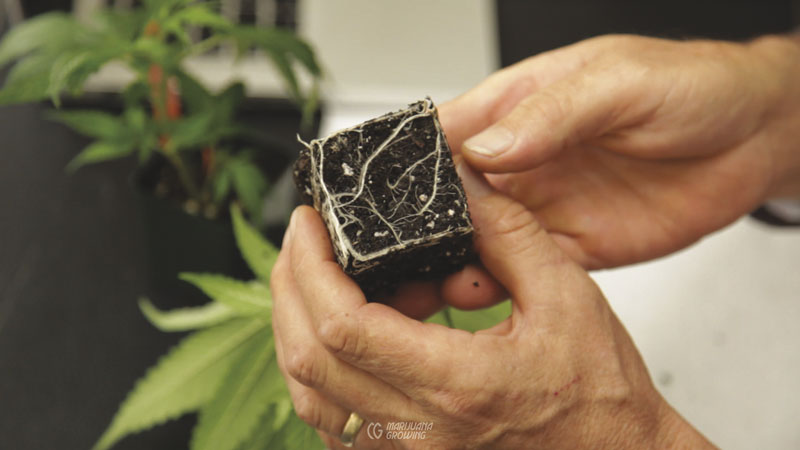
This clone is well rooted and prime for transplanting into soil or soilless mix. Roots will spread out and grow as soon as they come in contact with the new growing medium.
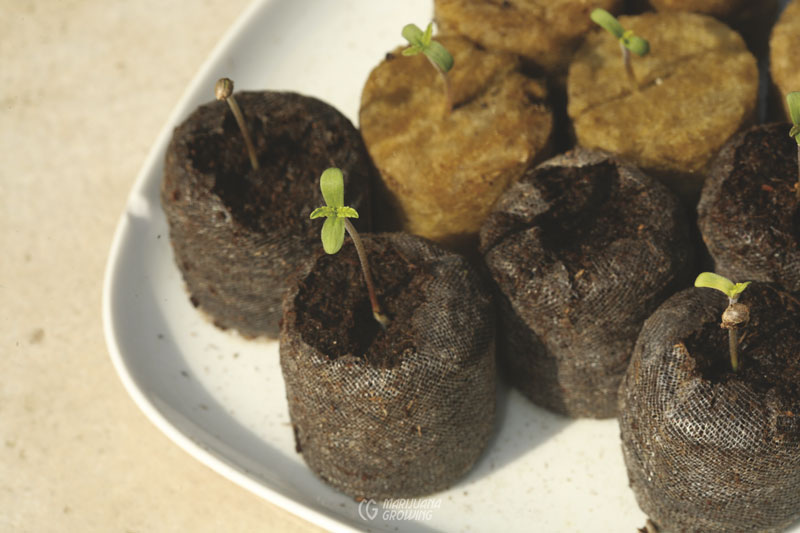
Rockwool cubes, or plugs, and Jiffy pellets are the two most popular rooting cubes for medicinal cannabis clones.
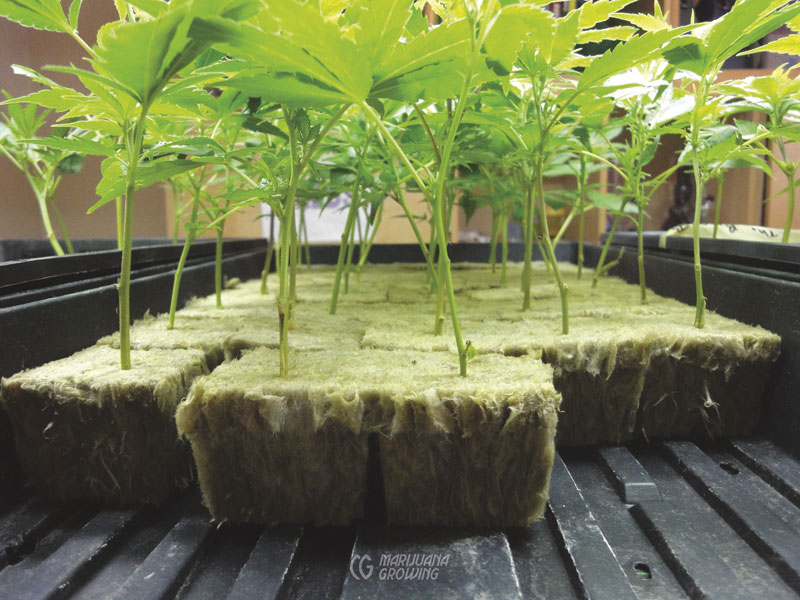
For many professional clone makers, Rockwool is the preferred growing medium in which to root cuttings.
Used, Indoor Soil Disposal
Disposing of used growing medium can be inconvenient for indoor gardeners. Soilless mixes and soils often contain perlite, which is unsightly in outdoor gardens. Dead roots must also be ground up in order to avoid other soil problems.
Dry soil is lighter and easier to work with and transport. Press and rub dry soil through a 0.25- to 0.5-inch screen to remove roots, stems, and foliage. Screened soil is easier to handle, contain, and transport. Some city gardeners actually place used soil in a trash compactor to reduce size and make it more manageable. Please do not dispose of used soil in the trash. Dump it where it will benefit other plants. Always separate transport bags from soil before disposal. Reuse the bags.
Used indoor growing mediums make excellent outdoor amendments when mixed with compost and garden soil. Do not reuse the depleted indoor soil in outdoor pots. Many of the same problems that occur indoors will happen in outdoor pots.

Used indoor soil can be unsightly in outdoor gardens.
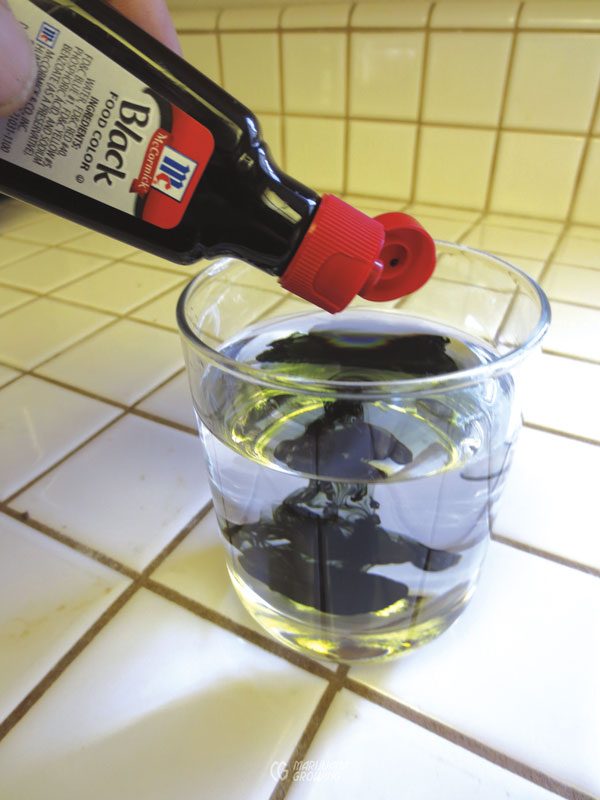
For many professional clone makers, Rockwool is the preferred growing medium in which to root cuttings.
Grow-Medium Problems
Visible Signs of Grow-Medium Stress
- dry, crispy, brittle leaves
- patchy or inconsistent leaf color
- yellow leaf edges that worsen
- crispy, burnt leaf edges
- chlorosis—yellowing between veins while veins remain green
- irregular blotches on leaves
- purple stems and leaf stems
- leaf edges curl up or down
- leaf tip curls down
- soft, pliable leaves
- branch tips stop growing
- leggy growth
Many maladies are caused by grow-medium problems but manifest as nutrient deficiencies or excesses. The solution is found within the growing medium.
When water is abundant in the growing medium, roots easily absorb it. Roots use more energy to absorb more water as it becomes scarce. Finally, the point comes when the substrate retains more moisture than plants are able to take in.
Well-rotted manure usually holds moisture well and is less prone to have viable weed seeds and pests.
Build compost piles high, and turn them regularly. Good compost recipes include the addition of organic trace elements, enzymes, and the primary nutrients (N-P-K). The organic matter should be ground up and in the form of shredded leaves and grass. Do not incorporate woody branches that could take years to decompose.
Before using compost indoors, pour it through 0.25-inch (0.64 cm) mesh hardware cloth (screen) to break up the humus. Place a heavy-duty framed screen over a large garbage can or a wheelbarrow to catch the sifted compost. Return earthworms found on the screen to the medium, and kill any cutworms you find. Make sure all composts are well rotted and have cooled before mixing with indoor and greenhouse soils. For more information about composting, see Let It Rot! Third Edition, by Stu Campbell (Storey Publishing, 1998).
Some gardeners mix up to 30 percent perlite into organic potting soil that contains lots of worm castings. Heavy worm castings compact soil and leave little space for air to surround roots. Adding perlite or similar amendments aerates the soil and improves drainage.
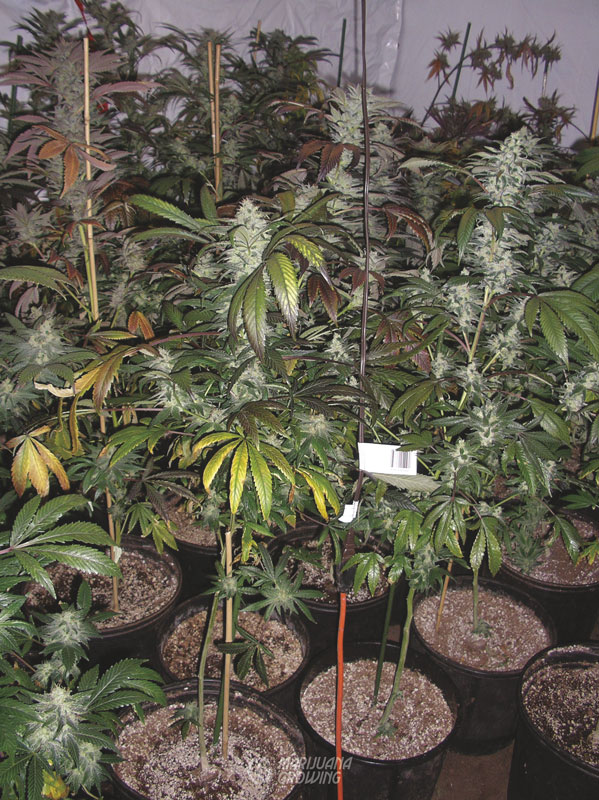
This sickly garden is a result of grow-medium stress.
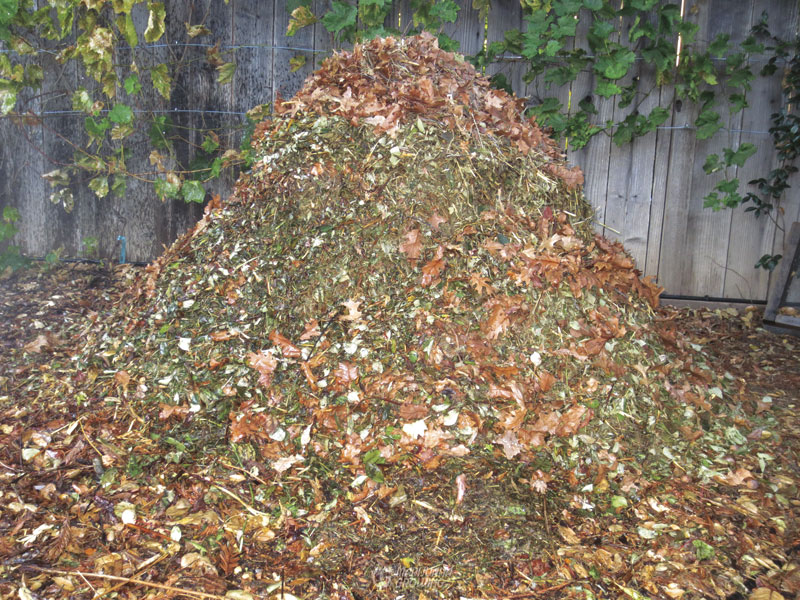
This compost pile is big enough to hold in heat and will decompose faster than a smaller pile.
Organic Soil and the Soil Food Web
Serious, conscientious medical cannabis gardeners grow 100 percent organically. Cannabis gardeners can use 100 percent chemical fertilizers with outstanding yields, but the overall health benefits of the plant may suffer. Use either 100 percent organic fertilizers or (less desirable) salt-based chemical fertilizers. Do not mix the two! Chemical fertilizers kill soil life. It is that simple.
The soil food web is the population of organisms living all or part of their lives in the soil. The soil food web is a complex living system in the soil, and it interacts with the environment, plants, and animals.
The soil food web is very complex and beyond the scope of this book to fully explain. For a basic description of the soil food web and to learn how you can work with it to achieve bountiful harvests, use a web browser to search for “Dr. Elaine Ingham.” She is the world authority on the soil food web. Also, pick up a copy of Teaming with Microbes, by Jeff Lowenfels and Wayne Lewis, for more information on the soil food web.
A properly functioning soil food web retains nutrients in the soil. Nutrients are bound and do not leach or volatize easily. Remember, nitrogen volatizes readily if not bound up; there has to be a continuous replacement source to feed the microbes or they will dip into the nutrient pools. A soil that is too active will outcompete the plants for available nutrients.
Nutrients are available in the proper forms and rates for plants to take up. Oxygen, water, and nutrients can easily move into and through well-structured soil. Roots can easily penetrate noncompacted soil. Disease-causing organisms are suppressed via competition with beneficial organisms. Plant surfaces, both above- and belowground, are protected from disease-causing organisms by beneficial organisms. Plant-growth-promoting hormones and chemicals are produced to stimulate larger, more productive root systems. Toxic compounds are decomposed by soil life when properly managed.
The following descriptions are basic overviews of different soil organisms in the soil food web. There are millions of species involved in the soil food web, and, as you might expect, we do not have space to describe all of them here.
Bacteria
Single-celled bacteria are so small that 250,000 to 500,000 of the little single-celled organisms could fit within the period of a sentence. Bacteria are one of the main decomposers of fresh, green, organic garden matter. Different bacteria eat different organic matter. They travel short distances and promote medicinal cannabis health. Once food and nutrients are inside bacteria, they are “locked up” until bacteria are consumed by predators. There are two groups of bacteria: aerobic and anaerobic.
Anaerobic bacteria do not need oxygen to survive. In general, anaerobic bacteria are to be avoided and not promoted. By-products of some anaerobic organic decomposition include hydrogen sulfide and butyric acid, both of which smell like vomit and ammonia with the fragrance of vinegar. If you know these odors, you know the smell of anaerobic decomposition. But other anaerobic organic decomposition does not cause unpleasant odors, and such decomposition has a sweet, earthy fragrance. Conditions that promote anaerobic bacteria include compacted soil with little pore space and standing water.
Aerobic bacteria need air to live and are the ones we want in the garden overall. Bacteria recycle three basic elements: carbon, nitrogen, and sulfur. Sulfur-oxidizing bacteria make water-soluble sulfates available to plants. The correct bacteria convert inert atmospheric nitrogen into “fixed” nitrogen—ammonium, nitrate, or nitrite ions. Bacterial slime (biofilm—DNA, proteins, and sugars) also buffers the rhizosphere so the pH remains reasonably constant. Bacteria are attached to particles of soil, and they lock up nutrients that stay in the soil and are not leached away. The nutrients stay in the same place in the soil and are not washed out. When other organisms eat the bacteria, nitrogen is released in their poop, right next to the rhizosphere where it is readily available.
Archaea
Similar to bacteria, archaea were discovered in the early 1970s. But single-celled archaea survive in both high- and low-temperature environments, and many produce methane. They are decomposers that break down and recycle organic and inorganic materials.
Fungi
Classified as lower plants, fungi produce no chlorophyll and do not need light to live. The majority of soil fungi are virtually invisible without being magnified by a microscope. Much larger than bacteria, fungi have many cells and can stretch threadlike growth (hyphae) many feet. They can transport nutrients along their length. Once inside the soil, fungus nutrients are “locked in,” and remain in the soil. Fungi also produce an enzyme that dissolves the woody compounds lignin, cellulose, and many others.
Fungi are the number one decomposers and decayers. Some fungi can decompose organic matter and move it from the soil surface down to the root zone in nutrient form. Fungi move nutrients, most notably phosphorus and sulfur, making them available to the plant. Other fungi move these nutrients horizontally in the soil to where they are needed. Some fungi trap destructive root-penetrating nematodes, absorbing nematode nutrients as nourishment. Fungi act as living banks for organic nutrients. Fungi are super fragile and do not grow well in compacted soil or when broken up by double digging and rototilling. Chemicals and salt-based fertilizers also destroy fungi.
Cannabis and the class of fungi, Mycorrhizae, form a complex relationship in the root zone, or rhizosphere. Two basic categories of mycorrhizae fungi include ectomycorrhizal and endomycorrhizal. Ectomycorrhizal fungi grow close to the root surface and are most common around conifers and hardwood trees. Organic cannabis gardeners are most interested in endomycorrhizal fungi that penetrate both roots and soil. The mycorrhizae react with nutrients outside roots and facilitate nutrient absorption and transport.
Specific types or species of mycorrhizae fungi form relationships with specific species of plants and make phosphorus, copper, calcium, iron magnesium, and zinc available. Nutrients are released for roots to take in when fungi die and decay. The key is to employ only the specific species of mycorrhizae that form the proper relationship. For more information see “Mycorrhizae” in chapter 22, Additives.
Endophyte fungi live in plant tissue all or most of their life. Excluding edible mushrooms and baker’s and brewer’s yeast and lichens, many are pathogenic to cannabis, including gray mold (Botrytis cinerea) and Fusarium. See “Gray Mold” and “Fusarium” in chapter 24, Diseases & Pests, for more information.
Algae
Algae are single-celled threadlike organisms, including seaweed and kelp. There are several kinds of algae, among them blue-green, green, red, and brown. They can inhabit saltwater, fresh water, and terrestrial environments, including soil. Algae need sunlight in order to grow and produce their own food.
Algae participate in creating soil by forming carbonic acids during their metabolism. They also form partnerships with other organisms, including fungi. Blue-green algae fix nitrogen using the nitrogenase enzyme. Overall, algae’s role in the garden is small, since algae grow at soil surface level and just below, and their growth is limited by sunlight penetration. Excess algae in soil will attract soil pests, including fungus gnats.
Slime Molds
Slime molds are slimy, amoeba-like organisms found in leaves, lawn thatch, manure, and other organic matter. Spores germinate in soil and ingest bacteria, fungi spores, and protozoa. The nutrients are thus “locked up” in the soil and prevented from leaching. Slime molds are eaten by larger predators, which digest them and then release nutrients into the soil. Slime molds surround their food and digest it internally. They are also food for larvae, worms, and beetles. Slime molds cycle nutrients and help bind soil particles together.
Protozoa
Protozoa are single-celled organisms with a nucleus within a single cell. In most cases, protozoa cannot make their own food; they survive by eating thousands of bacteria—and occasionally fungi and other protozoa.
Most of the 60,000 different kinds of protozoa are soil dwellers, but all of them need water for life, reproduction, and mobility. They travel in the thin layer of water enveloping soil particles. When this dries up they go into dormancy.
Protozoa and bacteria live in symbiotic relationships, yet at the same time, protozoa control bacteria populations. When they eat all the readily available bacteria, the big protozoa start consuming nematodes and smaller protozoa until the population becomes balanced once again. Wastes generated by protozoa are brimming with mineralized nutrients, including nitrogen compounds. Once the waste is in the soil, nitrogen-fixing bacteria, if present, convert ammonium (nitrogen) into the readily available nitrate form of nitrogen.
According to Jeff Lowenfels, coauthor of Teaming with Microbes, “As much as 80 percent of the nitrogen a plant needs comes from the wastes produced by bacteria- and fungi-eating protozoa.”
Nematodes
Nematodes are nonsegmented, thread-like, blind roundworms. Nematode waste is high in mineralizing nutrients liberated after consuming bacteria and fungi. There are more than 20,000 species of nematodes. Even though you can find 40 to 50 nematodes in a single teaspoon of good garden soil, most gardeners only know about the bad, root-eating nematodes. For more information on them, see “Nematodes” in chapter 24, Diseases & Pests.
Bacterivore nematodes live on bacteria. Their waste is loaded with mineralized nutrients. Predator nematodes eat algae, arthropods, fungi, other nematodes, protozoa, and even slugs! Wiggling and crawling through the soil, nematodes aerate and cultivate as they go. Soil structure and porous texture are essential for nematode well-being.
Arthropods
Beetles, flies, mites, mosquitoes, spiders, and springtails are all arthropods. About three-fourths of all living things are arthropods. These little critters have jointed legs and segmented bodies connected by a lightweight exterior skeleton (exoskeleton). Exterior skeletons are much stronger and give arthropods superhuman strength.
Arthropods aerate soil, shred organic material, and prey on other members of the soil food web, including bacteria, fungi, and other arthropods. Arthropods also promote fungal and bacterial activity in soil. Most live on or near the soil surface, but others burrow down into the soil, aerating it and leaving mineralized nutrient excrement in their path.
Unfortunately, most gardeners classify arthropods into three groups: bad bugs, bad insects, and others! Of course, most cannabis gardeners are familiar with a few bad ones—spider mites and thrips, to name a couple, but there are millions more, and many of them live in and are strategic to healthy soil and to medical marijuana. For example, mites (not bad spider mites) and springtails together are accountable for recycling as much as 30 percent of the forest floor in temperate climates. They want to work in your garden soil too!
We have dedicated a large part of the “Diseases & Pests” chapter to arthropods that are detrimental to plants. Just remember that not all bugs are bad!
You can find more than 300,000 mites in a square yard of good organic garden soil. Depending on the species, mites prey on members of the soil food web—nematodes, algae, fungi, decaying foliage, and other arthropods. They are also prey to other mites and arthropods.
Ants mix organic materials found on the soil surface, shredding them and toting them deep into their dens.
This is just the tip of the iceberg. We do not have enough space to discuss the rest of the arthropods, including beetles, spiders, centipedes, millipedes, earwigs, grasshoppers, crickets, lice, flies, bees, wasps, sow bugs, pill bugs, and a few million more, but you should have the idea of just how important they are for a healthy soil food web.
Earthworms
Earthworms are tube-shaped, segmented worms that range from 1 inch to 3 feet in length. Earthworms are easy to identify and are an indicator of healthy organic garden soil. Most gardeners are familiar with the night crawler (Lumbricus terrestris) that originated in Europe. And many gardeners know the common “red wiggler” compost worm (Eisenia fetida), which is native to the USA, but there are 7,000 more earthworm species, some of which are found in garden soil. Good organic garden soil has 10 to 50 earthworms per square foot. Each worm can move up to a pound of soil every year. A night crawler can move 6 times its body weight. That’s more efficient than rototilling, and it’s free! Earthworms till the soil, making better access for air, fungi, and other soil life while enhancing microbial life and improving water-holding ability.
Earthworms shred organic matter, aerate soil, aggregate soil particles, and move microorganisms and organic matter in the soil. They normally live in the top 6 inches of soil, but some species can burrow down 10 feet or more. Garden earthworms primarily eat bacteria but may also consume fungi, nematodes, and protozoa in addition to all the organic material they take in.
Once through the worm’s mouth, food is mixed with saliva, and powerful muscles start breaking it down before grinding it in the gizzard. Bits of sand help grind the mix before entering the intestines. Bacteria in the intestines then start to digest it. These bacteria produce nutrients that are absorbed into the worm’s bloodstream. Unused materials are eliminated in the form of vermicastings, also known as “worm castings.”
Vermicastings have 50 percent more organic matter than the same soil not digested and expelled by worms. Chemical bonds that make nutrients unavailable are liberated by this positively charged worm poop. Nutrients now have the ability to attach to soil particles and become available to roots.
Gastropods
Gastropods—slugs and snails—as well as some 40,000 other species form this group. Slugs and snails not only eat your plants, they also consume algae, fungi, and rotting organic matter. Many slugs can even digest cellulose. They shred their food to help decompose and decay organic material and organisms. They spend less than 15 percent of their life aboveground.
Reptiles, mammals, and birds Squirrels, mice, rabbits, chipmunks, moles, voles, gophers, snakes, salamanders, lizards, and birds may be annoying and even destructive in the garden, but they do have positive value. They move soil by burrowing, scratching, and simply moving their bodies, and in the process they move organic matter from one place to the other in the garden. They also defecate in the garden, adding available nutrient-rich nutrients. Birds in the garden demonstrate that worms, larvae, insects, and bugs are also in the garden. Bird poop (guano) is chock-full of nutrients and microorganisms. Bird feet transport protozoa that drop off as birds move about.
However, once moles and gophers have “moved enough soil,” you may want to escort them out of your garden. And once mice, rabbits, voles, and birds have eaten enough desirable plants, it is time for them to go too. See chapter 24, Diseases & Pests, for information on removing unwanted reptiles, mammals, and birds from your garden.
Salt-Based Fertilizers
Salt-based (chemical) fertilizers have the ability to destroy soil life; over applied, repeated applications continue to kill soil life—bacteria, fungi, insects, etc.—which weakens plants. If the first salt-based fertilizer application to organic garden soil does not kill all soil life, subsequent applications will finish it off. Outdoors, this scenario also prompts undesirable weeds to dominate the bleak environment.
Salt-based fertilizers are big business. Fertilizer manufacturers rely on low manufacturing costs and exponential profit margins. This “formula” allows for extravagant advertising budgets that are used to influence consumer purchasing.
Diseases and pests attack artificially supported plants. Harsh fungicides and pesticides are used to kill diseases and pests, which are secondhand problems caused by lack of soil life. Water and nutrients then leach from the soil at a faster rate, and more fertilizer is subsequently required. This downward cycle is repeated every time another fertilizer salt or killing substance is applied.
Garden and soil-life diversity is the key to healthy soil. Infuse, attract, and grow diverse soil friends and workers—bacteria, fungi, protozoa, arthropods, and beneficial nematodes. Bring life and teeming vitality back to your garden soil and grow healthy, organic, medicinal cannabis.
Rototilling Soil Kills Soil Life and Destroys Structure
Rototillers can do more work than people, but does this work need to be done? Ask the average farmer, gardener, or nurseryperson, and he or she will tell you that, yes, tilling is the way we have always done it. Tilling helps the soil; it breaks up clods and dead roots, and tills in and kills weeds. Uniformly tilled soil looks great, and most gardeners have a wonderful feeling of accomplishment after the garden or field is tilled.
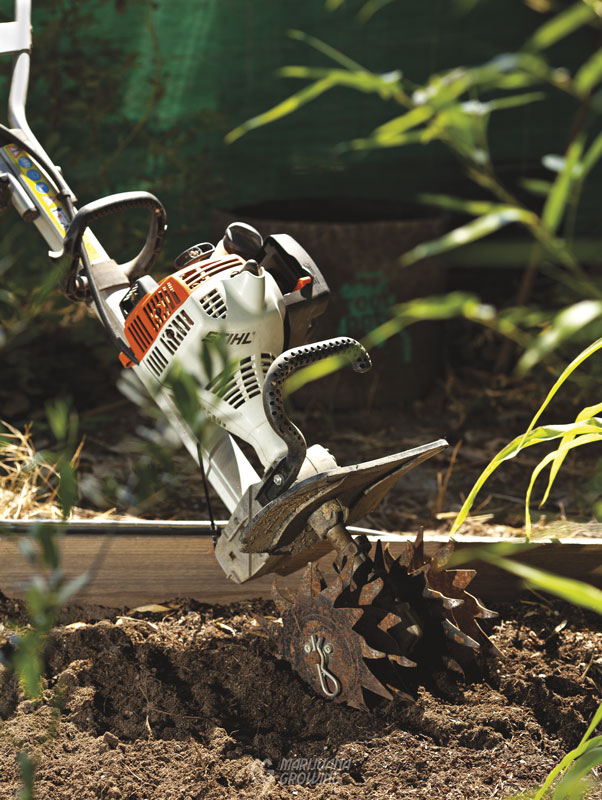
Ask well-informed organic gardeners if they till the soil, and you will receive a firm no. They understand that unnecessary tilling disrupts and kills soil life; it destroys the soil’s structure and water-holding ability. Instead of tilling, they add compost, organic teas, and fertilizers to promote soil life so that bacteria, fungi, protozoa, arthropods, and earthworms do all the work. These little creatures make nutrients available to roots, increase plant vitality, and help soil retain water and nutrients. Organic gardeners also selectively use natural fungicides or pesticides, some of which may kill soil life.
Mulch
Mulch is a protective cover placed on the soil to retain moisture, reduce erosion, provide nutrients, and suppress weed growth. Mulch keeps the surface of the soil from forming a hard, cakey layer, and it promotes a lively layer of roots and soil life below the surface.
Avoid using mulch in spring when soil is cool. Mulch insulates soil. It slows warming and prevents moisture evaporation. When mulches mat down, they form a barrier that blocks the flow of air and water between soil and atmosphere. Keep an eye on mulches because they may wick water from the soil surface and dry it out.
Apply mulch after soil has warmed in early to mid-summer. Soil temperatures will stay on target, and warmth will hold well into autumn. Mulch also slows evaporation, but do not forget that mulch can absorb rainfall and prevent it from penetrating soil. Irrigate mulched plants heavily so that water penetrates into the soil below.
Spread mulch by hand around plants. Keep mulch at least 6 inches or more away from stems to discourage diseases and pests. Finely chopped mulch is often more effective, but it decomposes faster than coarser mulch. A thick 6-to-12-inch (15–30 cm) layer of straw, hay, or grass mulch around a big plant in full sun will substantially reduce water consumption. Keep adding mulch as it decomposes.
Indoors, apply mulch such as expanded clay pellets or a piece of plastic that is cut to fit over containers.
Outdoors, almost anything can be used for mulch—rocks, sticks, newspaper, plastic, straw, hay, and more.
Composted mulch normally smells like freshly cut wood or sweet compost. Stay away from mulches that smell of ammonia, rot, sulfur, or vinegar, all of which signify anaerobic conditions.
Slugs, snails, mice, and other pests are attracted to mulch. Keep mulch 6 inches (15 cm) or more away from stems to discourage rodents from chewing stems. Place a plastic cuff around the base of plants to further discourage rodent damage. Use appropriate control measures for diseases and pests (see chapter 24, Diseases & Pests).
Cover crops protect soil in the off-season. These living mulches are tilled into the soil in the spring, adding nitrogen, organic matter, and other nutrients.
The roots of some cover crops such as alfalfa and clover fix nitrogen in the soil, providing they are cut and tilled before flower set.
Straw and alfalfa hay are my favorite mulches. Straw, available at farm and garden stores in compressed bails, is best used during warm weather to keep moisture from evaporating and to promote soil life. Avoid sources of hay and straw that could have been sprayed with growth regulators or herbicides that accumulate in foliage. Such straw also tends to have less available nitrogen, so the nitrogen pool in the soil is robbed for the decomposition process. Alfalfa hay is more expensive than straw, but it is heavy in nitrogen and adds it to the soil instead of robbing it from the soil. Alfalfa hay will biodegrade faster than straw.
High-carbon mulches such as straw, woodchips, and tree bark stay on the surface and are decomposed mainly by fungi, UV rays from sunlight, and weather. High-carbon mulches form a barrier that can deflect irrigation water. They can also wick water from the ground, but this is not common. If sticks are poked into the ground, they will wick water up toward dry wood. Mulch made from wood can contain or feed termites!
Shredded cardboard and newspaper make a good base to pile organic mulch on. To hold paper in place, wet it as you put it down.
Compost used as mulch should be well-rotted and void of weed seeds and heat.
Grass clippings are a high-nitrogen source that helps compost cook. My preference is to avoid adding grass that has been treated with herbicides such as Weed & Feed.
Leaves and leaf mold (composted leaves) tend to compact when they lay flat before adequate composting. Leaf mold is one of my favorite compost materials, especially when it comes from healthy hardwood trees.
Plastic bags, Visqueen, and plastic sheeting work well as mulch. I like to use biodegradable plastic, and have found that dark-colored plastic is less obtrusive than light-colored plastic.
A plastic mulch will shade weeds, prevent moisture loss, and raise the temperature of the soil by 5 to 15 degrees Fahrenheit (3–8 degrees Celsius) on a sunny day. As plants grow, their leaves will shade the plastic and stop the warming effects. A lake, pond, or small creek will also moderate air temperature, keeping it warmer in winter and cooler in summer. Do not use organic mulches in the spring; during that time of year they will cool the soil.
Rocks and gravel are great mulches. Rocks hold heat and retain it overnight. Rock mulches also extend growing seasons.
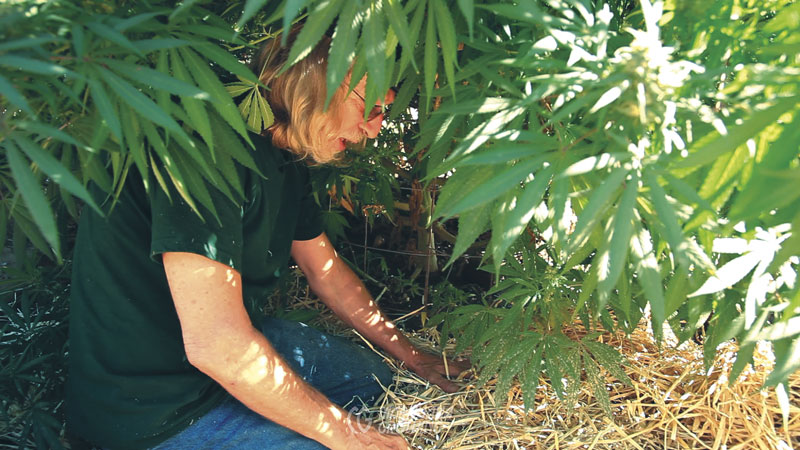
Indoors, outdoors, or in a greenhouse, mulch is often the least expensive way to conserve water, protect the soil, and reduce maintenance. Thumbs up for mulch!

